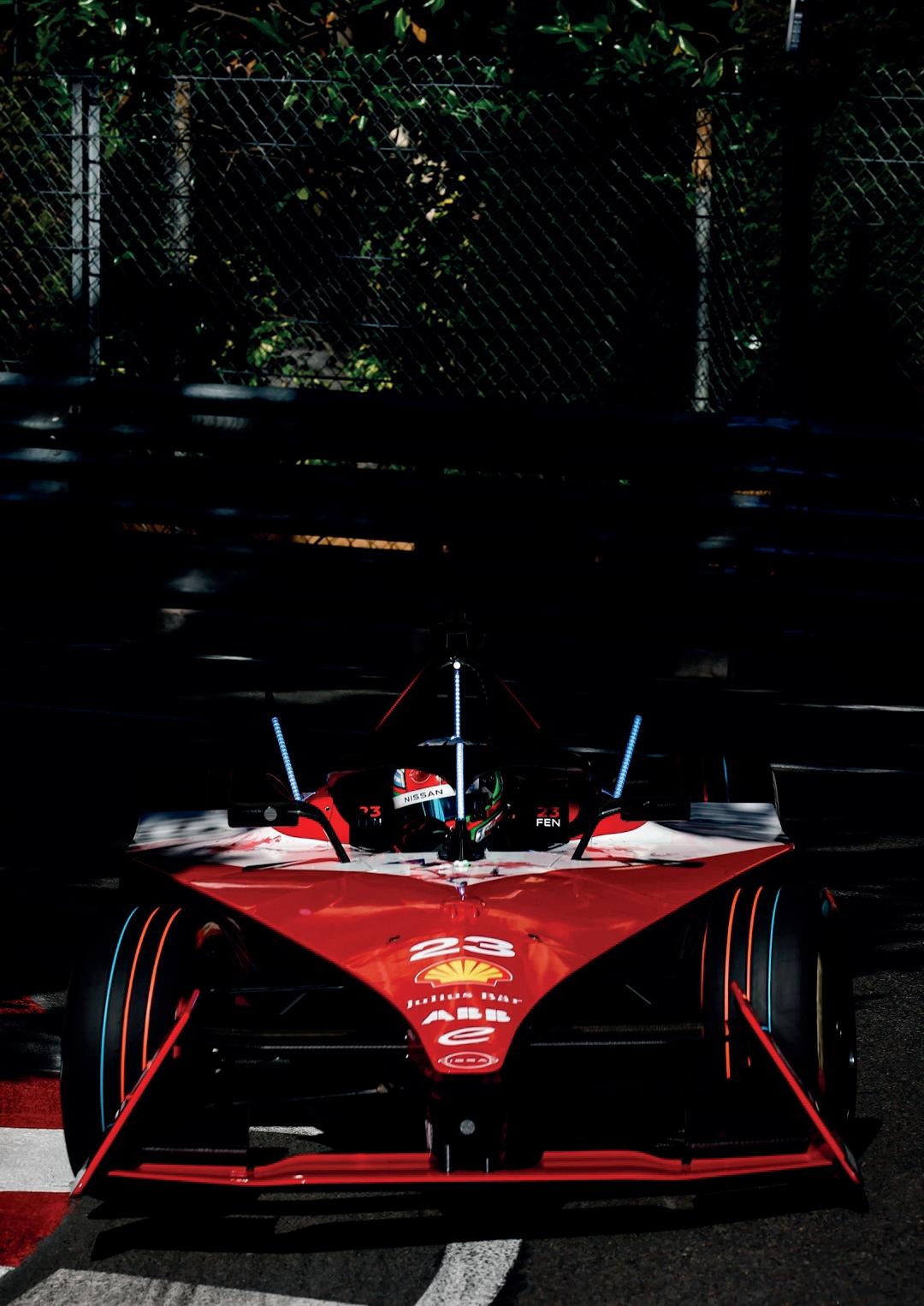

NEWS • REVIEWS • INTERVIEWS • ELECTRIC CARS • SOLAR • RENEWABLE ENERGY & SEPTEMBER 2023 FREE
SPECIAL ISSUE ELECTRIC MOTORSPORT FORMULA E &
Enjoy fast, rapid or ultra-rapid charging on 98% of our network.


Whether it’s local deliveries or long-range journeys, we’re here to keep your drivers and your business powered up for the road ahead.
Allstar One Electric. Got yours yet?
Allstar One Electric




MONTH/YEAR DATE one electric
TURNING ELECTRIC MAGAZINE
EDITOR’S NOTE
The Winning Formula
double-header which took place on the streets of London. The first race had absolutely everything, and despite a few scares along the way, Avalanche Andretti’s Jake Dennis secured the Driver’s Championship, becoming the first Brit to do so. You can find out exactly how he did that on page 11.
We have also recapped all the action from Season 9 with our double-page spread on page 13, and we also have some exciting Formula E on the very next page, which involves McLaren’s Jake Hughes and a Guinness World Record!
Our Top Ten feature this month is also dedicated to Formula E. Here, we count down the ten most unforgettable moments from this season, with everything from monster crashes, epic battles and even a few angry outbursts! Relive all the action on page 27.
Don’t worry, Extreme E fans, we’ve got you covered as well! We have ‘The Story of Season 3 So Far’ waiting for you on page 19, too!
We have a special issue of Turning Electric for you this month, with the majority of this magazine dedicated to Formula E and electric motorsport!
Following the thrilling finale to Season 9 of the ABB FIA Formula E World Championship, we have curated a whopping 18-pages with in-depth coverage, race reports, interviews and much, much more.
Kicking things off, we have an exclusive interview with Nissan Formula E Team’s Sacha Fenestraz. In his first full season in Formula E, Sacha made an instant impact, securing one pole position and two fourth place finishes. Head to page 7 to see what Sacha has to say about his first year in Formula E, his relationship with teammate Norman Nato and his hopes for next season.
Spoiler alert! In case you missed the final weekend of the Formula E season (and haven’t heard what happened) we have a full breakdown of the final

Away from electric motorsport, we have a close-up look at the brandnew, upgraded Volkswagen ID.3, an electric bike review from our very own Richard Alvin, and a roundup of the latest electric cars being released. Of course, all your usual columns and opinion pieces, as well as our Electric Home pages, are also inside!
Enjoy the read!
Charlie Atkinson
Editor, EV Powered
The Turning Electric Team
Editor
Charlie Atkinson
Associate Editor

Cherry Martin
Graphic Designer
Grace Moseley
Videographer
Jacob Pinchbeck
Content Sales Manager




Laura Phillips
Capital Business Media, Group MD
Richard Alvin
Business Development Director
Stephen Banks
Chief Creative Director
Stuart Hyde
Finance Director
Andrew Martin
3
Turning Electric is published in London by © EV Powered Ltd a Capital Business Media group brand. Turning Electric is printed using sustainable paper sources and vegetable ink, and is PEFC certified. Copies are recycled at the end of each month. Capital Business Media Ltd, Level 18, 40th Floor, London, E14 5NR. Tel: 020 7148 3861





Contents 5 8 Onwards & Upwards Exclusive interview with Nissan’s Sacha Fenestraz. 12 The King of England Jake Dennis claimed his very first Formula E World Championship. 16 The Story of Season 9 We take a look back on each round winner. 18 Formula E Car Hits 218km/H... ...indoors to smash Guinness World Record! 20 The Story of Season 3 So Far! With just four rounds left of the Extreme E season... EV News The latest from the EV industry. 26 22 The All-New Volkswagen ID.3 Here is everything you need to know! 16 20 24 Cube Nuride Hybrid EXC 625 Allroad A city rider’s dream by Richard Alvin. 26 What’s New? Monterey Car Week! A monthly round-up of all the latest releases and upcoming EVs! 28 Formula E’s Ten Most Unforgettable... ...moments from Season 9! 34 EV Research Would you pay for a bay? 35 Optimising Home Energy Systems... ...for EVs, with myenergi, Jordan Brompton. 38 Electric Home News The latest news and updates for everything Electric Home. 42 Making The Switch Transitioning from gas boilers to air source heat pumps. 45 Why Hydrogen Isn’t The Future... ...of heating homes & powering cars. 46 Leeds’ Trailblazing! With UK’s first solar-powered park and ride. 48 Green Energy Groups Step Up... ...training to close skill gap. 8 28 50 How Can Business Owners Save Energy... ...to reduce costs to save the environment.
VAUXHALL launches initiative to boost EV charging infrastructure as study finds more than 70% of UK councils have no charging strategy!
Vauxhall has teamed up with leading charge point operators to address the findings of an exclusive investigation that reveals more than 70% of UK councils currently do not have a published strategy in place for residential on-street charging for electric vehicles (EV), leaving millions of potential EV drivers without a place to charge.
The new findings from a Freedom of Information application across 414 councils and local authorities in England, Wales, Scotland and Northern Ireland also reveals that 69% of local authorities have yet to install any on-street chargers. In response, Vauxhall – which will offer a fully electric version of every car and van model in its line-up from 2024, and has pledged to only sell electric vehicles in the UK by 2028 – has set up the ‘Electric Streets of Britain’ programme to make sure drivers without driveways are not left behind in the transition to electric mobility.

Working with leading charging operators char.gy, Connected Kerb and SureCharge, Vauxhall has set up an ‘Enablement Fund’ to help councils understand the scale of on-street charging issues, and the solutions available, ahead of the Government’s planned ban on the sale of new combustion engined cars in 2030.
Vauxhall has also set up a new national database at http://electricstreets. co.uk/ for the public to register their needs, enabling councils to have a better understanding of where demand really lies for on-street charging for both existing and potential EV drivers.
James Taylor, Managing Director, Vauxhall, said: “Accessibility to charge points near your home is critical to the transition to electric vehicle ownership in the UK. We want to galvanise the needs and interests of everyone, from the public,to the councils and the charging operators to make sure that anyone without a driveway is part of that journey.
“We want to help educate and inform the decision-makers, and enable the installation of more chargers, more quickly.”
5 EV NEWS
SCOTLAND leading way on UK electric vehicle charge
Scotland is streets ahead of the rest of the UK, according to data from LeaseElectricCar.co.uk which revealed the areas across the country with the most charge points available for public use.

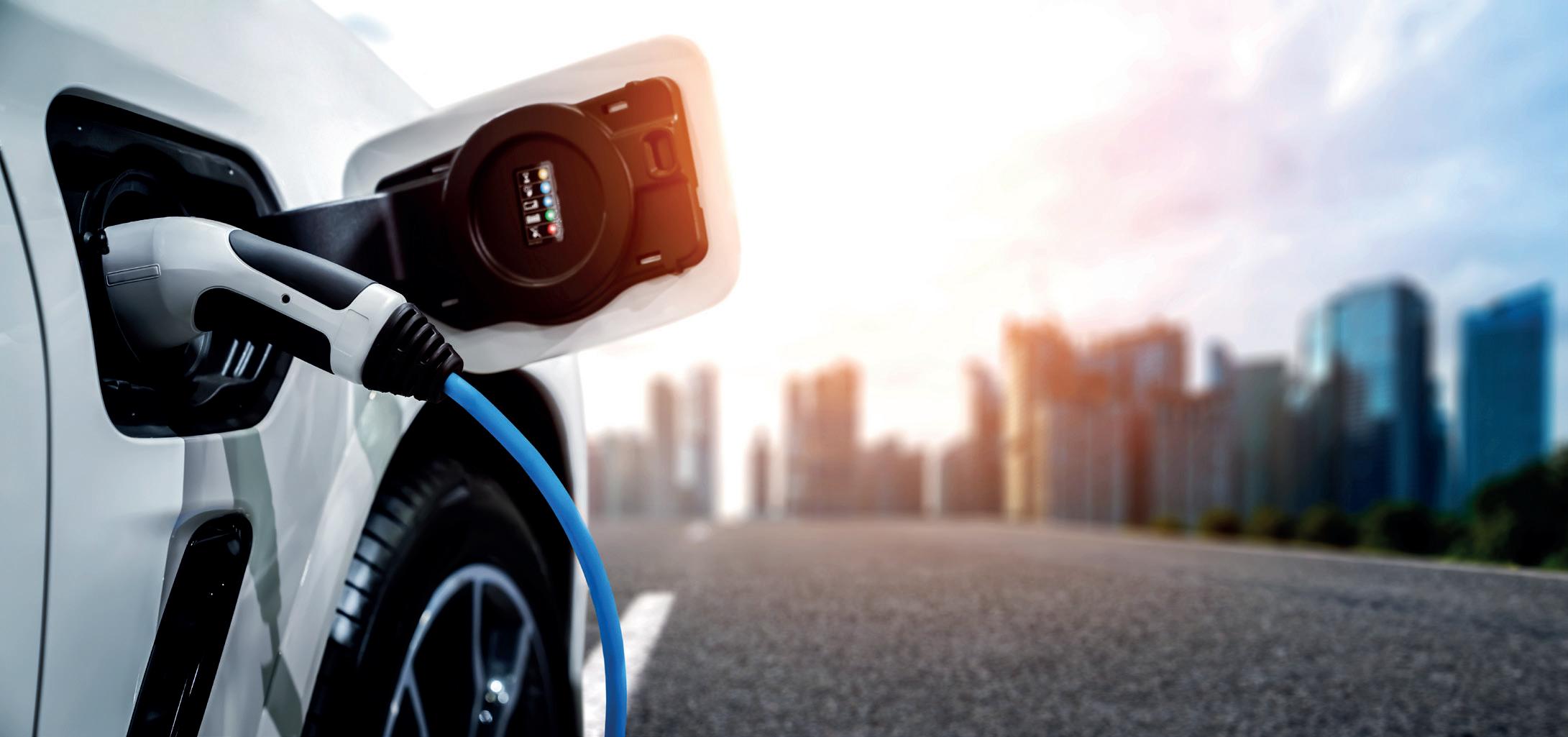
Scotland has the highest number of public rapid charging devices per 100,000 people –standing at 19.2. The easiest region in England to publicly charge up EVs is the West Midlands, which has 14.7 rapid devices per 100,000 of the UK population.
Because of high population numbers, London ranks tenth best for regions to use a public rapid chargepoint – with 10.7 per 100,000 people. Northern Ireland is significantly the worst UK region for publicly available rapid charging devices per 100,000 of the UK population – with just three available
MYENERGI partners with CINCH to further accelerate EV adoption
myenergi has announced a major partnership agreement with online car marketplace cinch that aims to bring EV home charging to the masses.
The collaboration will see the two brands work closely together to provide cinch customers with exclusive discounts on the purchase and installation price of the entire myenergi zappi range. Available to purchase through the cinch website, drivers can expect to see savings of up to £280 on both tethered and untethered models.
Jordan Brompton, co-founder and CMO of myenergi, commented:
“We’re delighted to be partnering with cinch. As two companies both committed to driving the future and accelerating the transition to electrification, it really is the perfect pairing.”
EV NEWS 6
Scotland REGION West Midlands South East North East South West NUMBER OF PUBLIC RAPID CHARGING DEVICES PER 100,000 OF UK POPULATION 19.2 14.7 13.5 13.3 13.2 East Midlands Yorkshire and the Humber Wales East of England 12.8 12.7 12.2 11.6 London North West Northern Ireland 10.7 9.9 3
SECOND HAND EV SALES up in second quarter
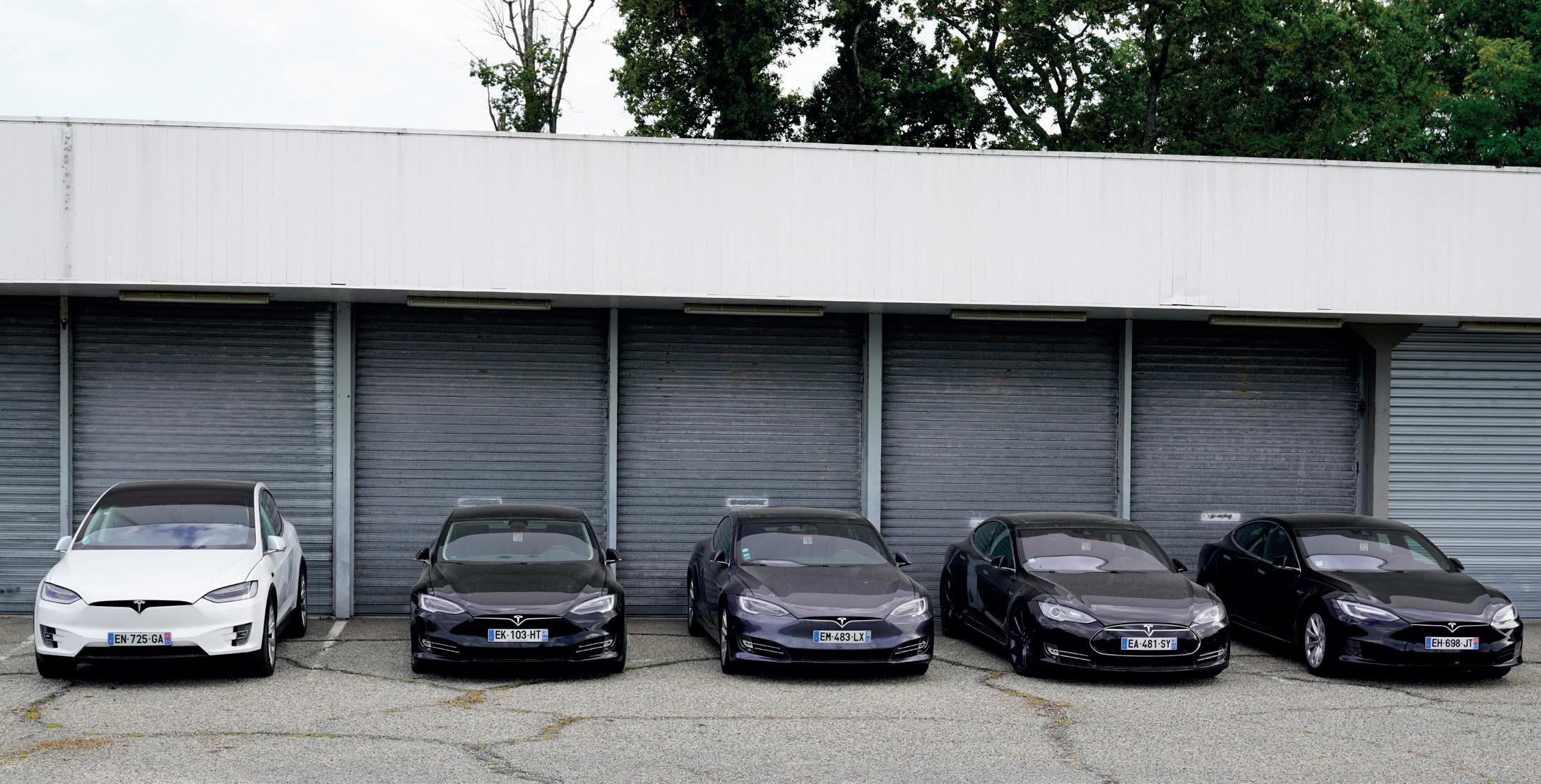
Sales of used battery electric vehicles (BEVs) grew by a whopping 81% during the second quarter of the year, figures from the SMMT reveal.
RECHARGE
RECHARGE UK is calling for all public electric vehicle charging sites to have accessible charging mandated.
According to the latest figures published today by the Society of Motor Manufacturers and Traders (SMMT), the UK’s used car market rose by 4.1% during the second quarter of the year, with 1,832,267 units changing hands.

Used battery electric vehicle (BEVs) sales continued to soar in the second quarter, growing by 81.8% to 30,645 units, representing 1.7% of the market – a new record – up from 1.0% last year. Doubledigit growth also continued for plug-in hybrids (PHEVs) and hybrids (HEVs), up 11.4% to 18,437 units and 29.5% to 53,634 units respectively. The rising proportion of electrified vehicles meant that market share for conventionally powered cars marginally fell to 94.3% from 95.7% last year, even though volumes of petrol and diesel cars saw growth of 2.5% and 2.8% respectively.
The group, which is the EV arm of the REA (Association for Renewable Energy and Clean Technology), says that mandating accessibility requirements for public electric vehicle chargepoints will ensure wheelchair users always have equal access to charge their vehicle.
Matthew Adams, Transport Policy Manager at the REA (Association for Renewable Energy and Clean Technology) said: “Electric vehicles are for everyone and all those that want to lower their carbon footprint and save on running costs by purchasing or using an EV should be able to do so. However, currently what we see is some charging infrastructure that is not built with wheelchair users and those with accessibility requirements in mind, in many cases.
“RECHARGE UK is calling for Government to mandate that all public charging sites, where feasible, must have accessible charging mandated, as we believe electric vehicles are for everyone and we should seize the opportunity to design accessible infrastructure from the ground up as we know such sites can and often do, provide a much better experience than a petrol pump.”
NEWS IN BRIEF
Webfleet, Bridgestone’s fleet management solution, has smashed the Guinness World Record title for the greatest distance travelled by an electric van on a single charge – 311.18 miles.
Volkswagen Group is strengthening its position in the Chinese automotive market with co-operations between the VW brand and XPENG and between Audi and SAIC.
A new study by Direct365 has revealed that Tesco is the most EV-friendly brand with 774 EV stations in the UK, almost two thirds more than Morrisons (273).
Nissan Formula E Team drivers Norman Nato and Sacha Fenestraz have been teaching kids about electric vehicles as part of Nissan’s new EV School series.
Mercedes-Benz in the UK has chosen smart charging company Ohme as its new official home charging partner.
7 EV NEWS
UK calls for EV accessibility standards to be mandated
WARDS UPWARDS &
ON
In this exclusive interview, Nissan’s Sacha Fenestraz reflects on his first year in Formula E


Sacha, the season has just finished, how do you reflect on your first season in Formula E?

It’s been a busy after-season. London wasn’t what I was hoping for. I was hoping for a better result, but a little mistake on my side didn’t really help that. But overall, I’m quite happy for this season. I wasn’t expecting two poles and fourth twice so early in in my Formula E career, especially when you see the level of drivers that that we’ve got in the Championship. I surprised myself a little bit sometimes, but it was it was a great season and now I’m really looking forward to the next one.
What does the process of preparing for next season look like?
It’s a lot of analysing of what really happened throughout the season because we had many races back-to-back where you don’t really have time to just settle down and really analyse what happened here, what happened there. Now it’s time to do those things. It’s a lot of study in a way; it’s all about trying to erase mistakes next year. I’m still learning a lot, like all the energy management side of things et cetera, so it’s a lot of work just analysing what happened and learn from those mistakes and bring on the second one.
What have been some of the biggest lessons you’ve had to learn this year?
A lot of the energy management side of things, of course. It’s something that is still extremely new for me. It’s something that I need to get better at. That’s
definitely my weakest point at the moment, so I would say that’s the biggest lesson that I’ve had this season. Also, racing in such a high professional level. I’ve learned a lot and it’s a bit of a different racing style to what I was used to. There’s been a lot of learning with the how to properly drive the car. It’s not straightforward at all, and it’s very, very difficult.
How challenging is Formula E as a driver?
Firstly, for people who doesn’t really know Formula E, we race in city tracks at over 200mph. Where the margin for error is very, very slim. This is with a car that is very tricky to drive. Then on the energy management side, you start the race with not enough energy and you need to recover a lot of energy to reach the end. Of course, the car helps you, tells you where to lift sometimes, maybe even where to brake, but the car is not perfect. Sometimes things will change throughout the race. You have over 300 options to change on the steering wheel, so every lap we’re constantly changing things, talking with the engineer. It’s extremely, extremely busy in the car and in the race. It’s not just driving around and that’s it. You have a lot of things to take on when you’re going to overtake. You just need to be very clever and be 99% sure that you’re going to make the move, because if not, you’re just wasting energy. It’s a lot of strategy for the drivers to manage that.
Continue onto next page
9 SACHA FENESTRAZ INTERVIEW AN
How would you describe the feeling of being behind the wheel of a Formula E car?

I love it. I’ve always really, really loved street circuit racing, it’s such an adrenaline rush and requires so much finesse in a way that you cannot allow yourself to make any mistakes. As I said earlier, the margins are very, very slim. There is one racing line and if you go off a little bit, there might be dirt, there might be a lot of sand. It depends on the track, so it’s very cool. It’s a lot of adrenaline, a lot of pressure. Also, of course, you’re racing in such a high level Championship with, I would say, the best drivers in the world, along with Formula One. I’m enjoying it a lot.
What have been some of your favourite locations and circuits from the past season?
I would say Cape Town, I had the pole there, but not just because of the pole. The racetrack was really, really cool. One of the nicest racetracks of this season; the location by the sea was really nice. Then, of course, Monaco is the typical one. I’ve raised there in the past but it’s so cool to be able to be racing all around the world. Next year we go to Tokyo, our [Nissan’s] first home race. We’re expanding every year and I’m really looking forward to next year and what’s going to happen in ten years’ time in this Championship. It will be crazy where we’re going to go, I think.
Have you noticed a growth in popularity in Formula E?
Yes, definitely, and especially when I started working as a reserve driver, I could see how it was progressing. If you think of where it started with two
SACHA FENESTRAZ 10
cars in one race, jumping from one car to another one because the battery was reaching the end, and now we are with one car, a lot more power, a lot lighter, longer races etc. The progression is massive. The Championship is still growing, we still see high quality drivers. I think it’s going to keep on evolving.
What is your relationship with your teammate, Norman Nato, like?
It was really cool. I honestly enjoyed working with him a lot. It was a great season. We had a lot of fun on and off the track. When we were on track, many times we had to switch position and it was never a problem. He’s been a great teammate. I’ve learned a lot with him, especially when I had the chance to start in the front row a few times this season and he was helping me with just what to expect, to just be careful with this and that and, even apart from those things, the energy management, which is my weakness, it’s been very helpful to just be able to analyse myself with him. He’s been doing a great job, especially at the end of the of the season with Rome and London.
What are your goals for next season?
I don’t know where we’re going to be compared to the rest of course; it’s difficult to compare right now but I think, for me, achieving some podiums, that would be an amazing target if I can achieve it. I would be extremely happy. In terms of Championship results, if I can finish in the top six, that’s a good target right now. This year was a bit difficult, of course, as the first season we were quite far back and have been quite unlucky also. But I think top six, top five in the Championship, that would be quite a cool achievement, but hopefully it’s better than that.
INTERVIEW AN
“
IF YOU THINK OF WHERE IT STARTED WITH TWO CARS IN ONE RACE, JUMPING FROM ONE CAR TO ANOTHER ONE BECAUSE THE BATTERY WAS REACHING THE END, AND NOW WE ARE WITH ONE CAR, A LOT MORE POWER, A LOT LIGHTER, LONGER RACES ETC. THE PROGRESSION IS MASSIVE. THE CHAMPIONSHIP IS STILL GROWING, WE STILL SEE HIGH QUALITY DRIVERS.


I THINK IT’S GOING TO KEEP EVOLVING. ”
Scan this QR code to listen to the Everything EV Podcast with Sacha!

THE KING
OF ENGLAND
Avalanche Andretti’s Jake Dennis claimed his very first Formula E World Championship on home soil with a second-place finish in a chaotic London E-Prix.

ROUND 15
It was Jaguar’s Mitch Evans that won the race but all the headlines will be dedicated to Dennis, who becomes the first British Formula E World Champion!
Dennis came into the weekend with a 24-point lead at the top of the Drivers’ Standing’s but faced stiff competition from his closest title rival, Nick Cassidy, who started at the front of the grid.
Jaguar’s Mitch Evans had secured pole position, which handed him and Jaguar a much-needed three-point boost, but the Kiwi was kicked back to sixth on the grid following a five-place penalty for his incident in Rome last time out.
Dennis started the race in second, with Cassidy’s teammate Seb Buemi, just behind in third. As soon as the race started, Buemi muscled his way past Dennis to set up an Envision one-two from just the first corner. It was a nightmare start for Dennis, but there was plenty of action yet to come.
As Evans made his way up the order and eventually into first place, the real battle was unfolding between Dennis and Cassidy.
With Buemi lending a helping hand keeping Dennis stuck outside of the podium positions, Cassidy looked to be taking the Championship down to the final day. However, on Lap 23, disaster struck for Cassidy as he suffered damage to his front wing, with a piece getting stuck under his car, sending him right to the back of the grid.
Cassidy pulled into the pit and was fitted with a new wing, but after just a few laps, the Kiwi’s race was over and so were his title chances. Despair for the Envision driver, but it presented the
perfect opportunity for Dennis, who now needed to secure just a third-place finish to become the first British driver to win the Formula E World Championship.


WE’RE BREAKING OUR OWN RECORDS RIGHT NOW.
visit from the Safety Car, a red flag was waved and all the cars pulled into the pit lane.
The break saw a few changes to the order, with Porsche’s Pascal Werhlein handed a grid penalty which sent him to the back of the grid, meaning Dennis, now in fourth, needed to gain just one more position to secure the title.
With Evans still out in front, Jake Dennis saw an opportunity to jump into third place when Seb Buemi dipped off-line to use his last Attack Mode. Then, one lap later, another red flag was waved as a huge crash at Turn 19 involving Nissan’s Norman Nato, Jaguar’s Sam Bird and Envision’s Buemi caused every other car to come to
a halt behind them. It was one of the most unique sights in Formula E history, but the incident had severe consequences for the Teams’ Championship as both Envision’s had crashed out.

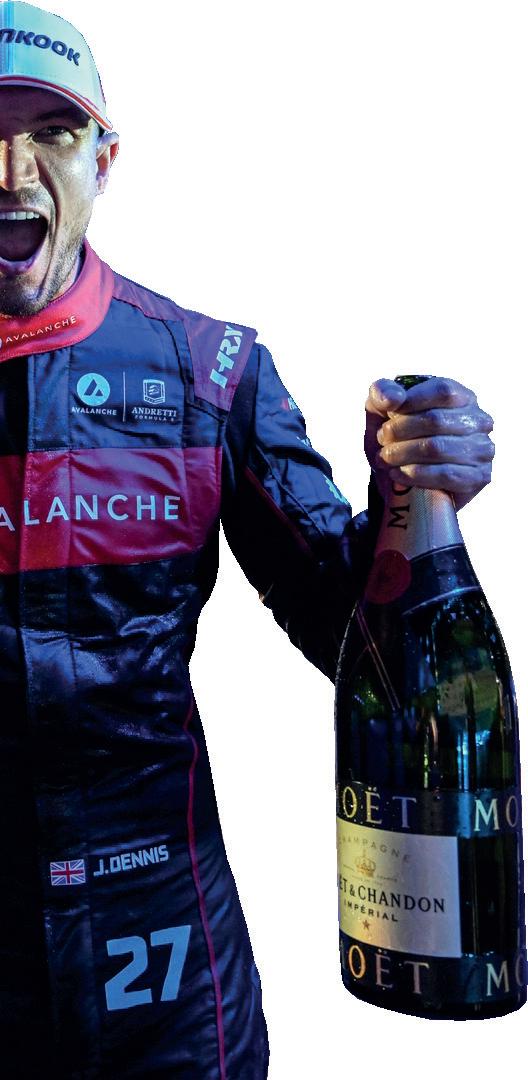

Once the race restarted again, it was plane-sailing for the Brit as he held onto his third-place position to secure the World Championship! Evans won the race and Antonio Felix Da Costa, who crossed the line in second, was handed a three-minute time penalty which elevated Dennis up into second. Buemi thankfully recovered from the incident earlier on to land the third spot on the podium and to keep their Teams’ Championship hopes alive!
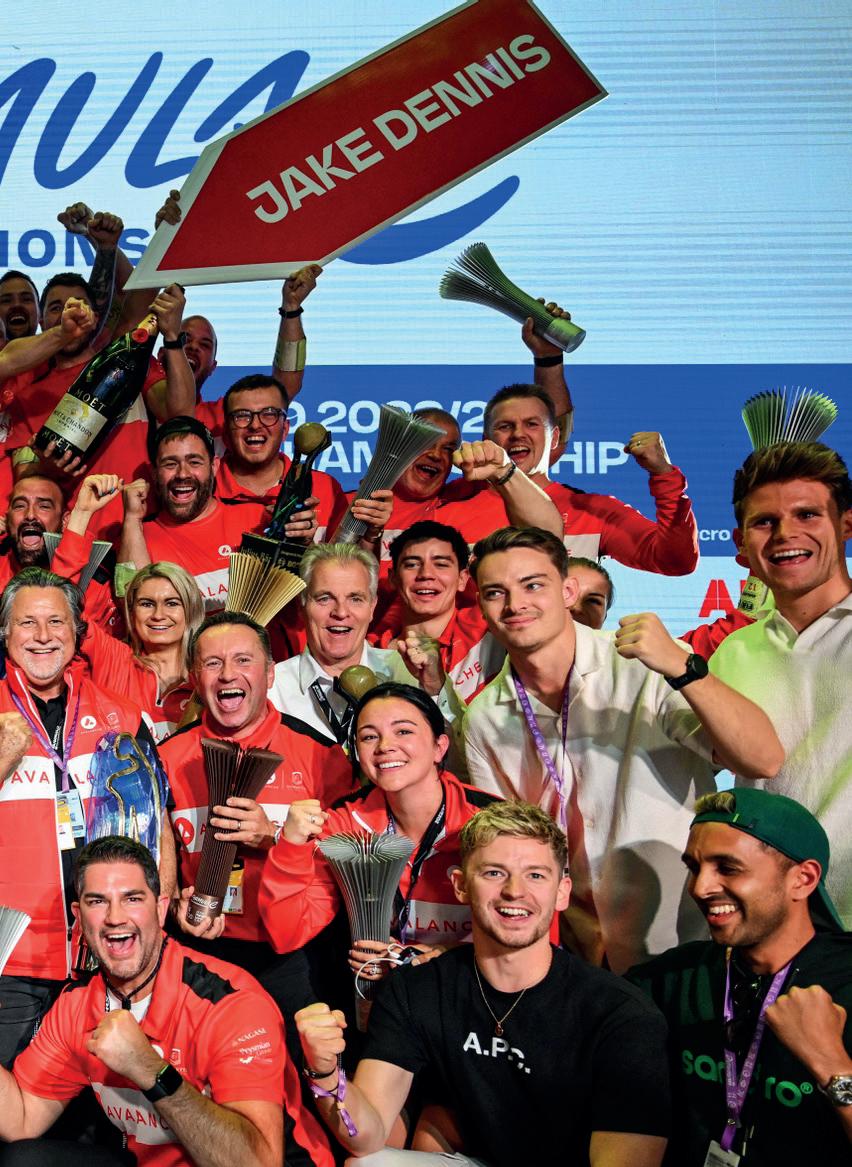
ROUND 16
Envision’s Nick Cassidy responded to his World Championship heartache by winning the final race of Season 9 at London’s ExCel circuit.
Cassidy had all but handed the World Championship to Avalanche Andretti’s Jake Dennis on the Saturday after damage to his front wing brought his race to a premature end, meaning Dennis only needed a third-place finish to secure the title.


Dennis eventually claimed second-place and the Championship, becoming the first Brit to win the Formula E title and the first World Champion of Formula E’s Gen3 era.
Following the disappointment of Saturday, however, Cassidy conquered the wet conditions, leading from lights to flag to land his fourth win of the season. The victory also secured the first Teams’ World Championship for Envision Racing.

In the end, Cassidy pipped his compatriot Mitch Evans of Jaguar TCS Racing to the top spot, with the newly crowned World Champion Jake Dennis rounding out the podium positions. Nissan’s Norman Nato claimed a seasonbest fourth place finish, coming in ahead of outgoing World Champion Stoffel Vandoorne of DS Penske. The rest of the top ten consisted of Cassidy’s teammate Seb Buemi, Jaguar’s Sam Bird, ABT Cupra’s Nico Mueller, NIO’s Dan Ticktum and Porsche’s Pascal Werhlein.
That final round of Season 9 left Envision Racing the Teams’ World Champions – their first title, with a prior best of third. Dennis wound up 30 points clear of Cassidy in the Drivers’ running, with Evans third and Wehrlein fourth.


“We’re beating our own records right now. To get the podium at the end of the day was special in such difficult conditions with the wet and dry sections – but we managed to do it, keep it out of the wall and we were pretty quick, but we needed to be. I think we needed a clean race, try and get that podium, celebrate now with everyone and really try and let it all sink in.
“I have to thank these guys, all of them [the team]. They’ve done so much hard work not just this year but also last year. It’s been such a team effort and we scored so many wins, so many pole positions and so many podiums. I get to celebrate with them together so I’m looking forward to that, call it a season and come back next year. I’ll be hungover tomorrow! I don’t know what my drink of choice will be but there will be one.”
JAKE DENNIS
that just shows how strong they have been in this championship, and to finally get it done for them I am super super happy.”
NICK CASSIDY ENVISION RACING
FORMULA E 14
“It’s mixed emotions but ultimately I’m very happy because today was a difficult day for me mostly because I didn’t sleep well last night, I arrived late – but I did the business so I’m proud. The team have been absolutely incredible. They’re an incredible bunch of people and they work so hard. Of course every team does but these guys have been close on so many occasions and I think
AVALANCHE ANDRETTI FORMULA E TEAM
DRIVERS’ STANDINGS


TEAMS’ STANDINGS

Jake Dennis Avalanche Andretti Formula E 229 PTS Nick Cassidy Envision Racing 199 PTS Mitch Evans Jaguar TCS Racing 197 PTS Pascal Werhelin TAG Heuer Porsche Formula E Team 149 PTS Jean-Éric Vergne DS Penske 107 PTS Sébastien Buemi Envision Racing 105 PTS Max Günther Maserati MSG Racing 101 PTS Sam Bird Jaguar TCS Racing 95 PTS António Félix da Costa TAG Heuer Porsche Formula E Team 93 PTS Norman Nato Nissan Formula E Team 63 PTS 1 2 3 4 5 6 7 8 9 10
Envision Racing 304 PTS Jaguar TCS Racing 292 PTS Avalanche Andretti Formula E 525 PTS TAG Heuer Porsche Formula E Team 242 PTS DS Penske 163 PTS Maserati MSG Racing 140 PTS Nissan Formula E Team 95 PTS NEOM McLaren Formula E Team 88 PTS NIO 333 Racing 42 PTS Mahindra Racing 41 PTS 1 2 3 4 5 6 7 8 9 10 ABT Cupra Formula E Team 21 PTS 11 Images courtesy of Formula E.
THE STORY OF SEASON

ROUND 1
MEXICO CITY, MEXICO
WINNER: JAKE DENNIS AVALANCHE ANDRETTI
ROUND 2 & 3
DIRIYAH, SAUDI ARABIA
WINNER OF BOTH: PASCAL WERHLEIN PORSCHE

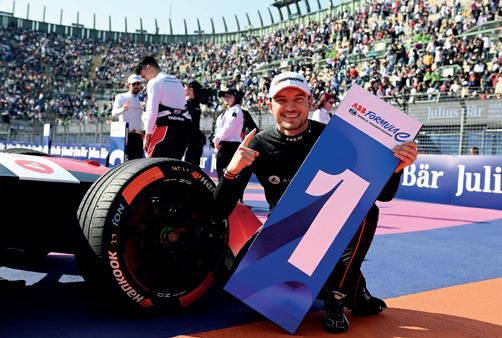
ROUND 4
HYDERABAD, INDIA
WINNER: JEAN-ÉRIC VERGNE DS PENSKE




ROUND 6
SAO PAULO, BRAZIL
WINNER: MITCH EVANS JAGUAR TCS RACING
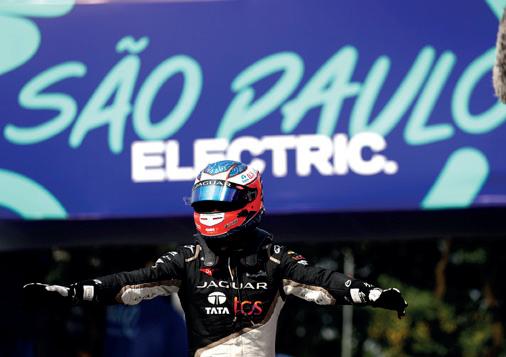
ROUND 5
CAPE TOWN, SOUTH AFRICA
WINNER: ANTONIO FELIX DA COSTA PORSCHE

ROUND 7 & 8
BERLIN, GERMANY
ROUND 7 WINNER: MITCH EVANS JAGUAR TCS RACING
ROUND 8 WINNER: NICK CASSIDY ENVISION RACING
ROUND 9
MONACO
WINNER: NICK CASSIDY ENVISION RACING

FORMULA E 16
SEASON 9
JAKE DENNIS CROWNED WORLD CHAMPION




ROUND 15 & 16
LONDON, UK
ROUND 15 WINNER: MITCH EVANS
JAGUAR TCS RACING
ROUND 16 WINNER: NICK CASSIDY ENVISION RACING

ROUND 10 & 11
JAKARTA, INDONESIA
ROUND 10 WINNER: MAX GUENTHER MASERATI MSG RACING
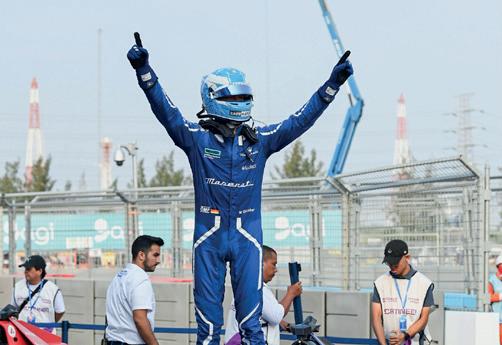

ROUND 11 WINNER: NICK CASSIDY ENVISION RACING
ROUND 12
PORTLAND, USA
WINNER: NICK CASSIDY ENVISION RACING

ROUND 13 & 14
ROME, ITALY
ROUND 13 WINNER: MITCH EVANS
JAGUAR TCS RACING

ROUND 14 WINNER: JAKE DENNIS
AVALANCHE ANDRETTI
17 FORMULA E
FORMULA E CAR HITS 218 INDOORS TO SMASH GUINNESS WORLD

A revolutionary Formula E electric race car, the GENBETA, has smashed the indoor land speed world record by more than 50 km/h reaching a top speed of 218.71km/h (135.9mph) inside a building in London.
The official GUINNESS WORLD RECORDS title was achieved by driver Jake Hughes of NEOM McLaren Formula E Team who competed with ABB FIA Formula E World Championship rival, Mahindra Racing team driver Lucas di Grassi, to set the world record for the fastest speed achieved by a vehicle indoors.


The pair went head-to-head in the ‘Duels’ format used in qualifying for Formula E races to see who could set the fastest speed indoors, on just 346 metres of straight race track, using the same GENBETA car.

Neither driver had ever been behind the wheel of the GENBETA before, but both beat the previous world record of 165.2km/h (102.65 mph) set in February 2021 on all three of their practice runs before their official world record attempts.
Britain’s Jake Hughes was the first to go with three practice drives, instantly becoming the unofficial world record holder with his first run of 214.80 km/h. He then pushed that unofficial world record even further in his next two practice runs with recorded speeds of 215.05 km/h and 217.65 km/h.
Hughes, in his first season of racing in Formula E, set off on his fourth and official run. He achieved a top speed of 218.71 km/h (135.9 mph) earning him the world record title before the onlooking Lucas di Grassi entered the competition.
The Brazilian started strongly with a first run of 216.87 km/h, faster than Hughes’ initial practice, and looked to be on course to snatch the world record from his championship rival when his next practice clocked 217.92km/h before the third and final practice hit 218.18 km/h, a fraction off Hughes’ official world record.
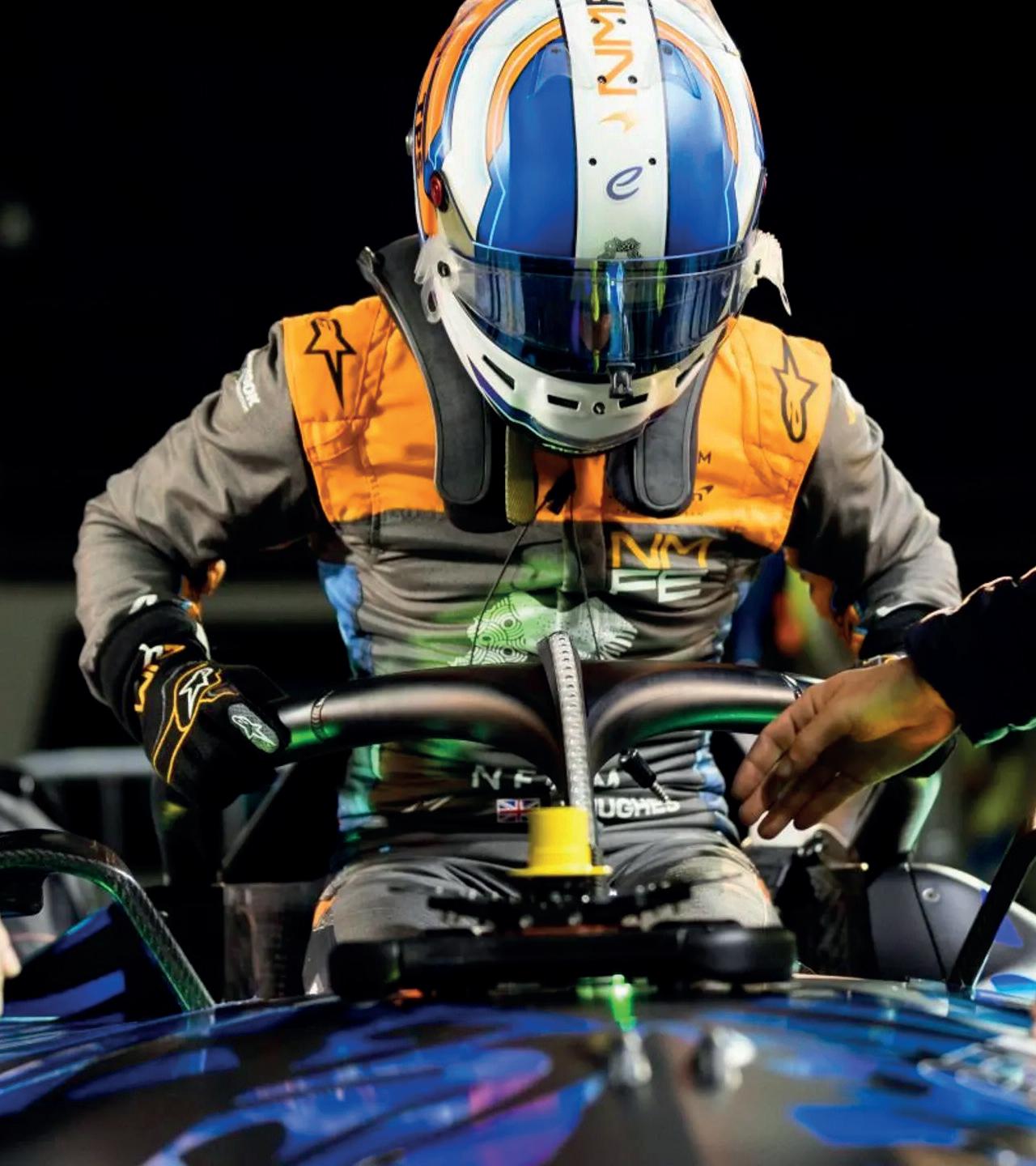
Alas, it was not to be for the former Formula E champion who won the first-ever Formula E race in Beijing in 2014 and is the most successful driver in the history of the championship. His fourth and official run achieved a top speed of 217.65 km/h meaning Hughes had won this unique Duel and was officially declared the holder of the GUINNESS WORLD RECORDS title as driver of the fastest-ever vehicle indoors.
The GENBETA car driven by both drivers to set the new world record featured a range of modifications to effectively ‘unlock’ the specifications of the GEN3 race car. Introduced this season in Formula E, the GEN3 is the fastest, lightest, most powerful and efficient electric race car ever built. With a top speed of more than 322 km/h (200 mph), the GEN3 is used by the 11 teams and 22 drivers in the ABB FIA Formula E World Championship.
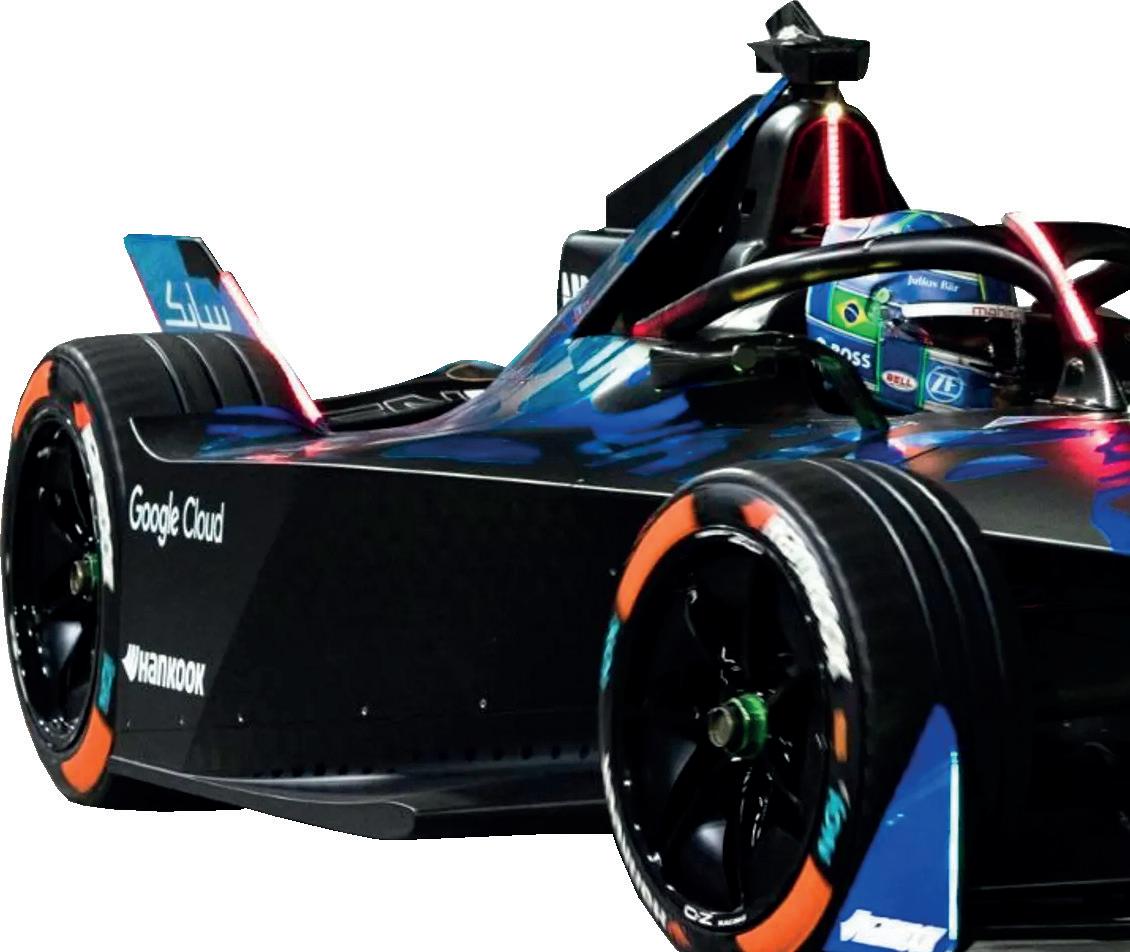
FORMULA E 18
218km/H WORLD RECORD!
The modifications to the GEN3 as part of the GENBETA project include:
Enhanced battery power output of 400kW, up from 350kW in the GEN3, through the activation of the front powertrain kit in traction, delivering allwheel drive for the first time in a Formula E car. The battery was charged by ABB, the title partner and official charging partner of the Championship.

• New, softer iON Race tyre compound allowing faster warm-up and better peak grip, developed by Hankook Tire, official tyre supplier of Formula E.
3D printed front wing endplates, wheel fins and a wind deflector with circular, more sustainable thermoplastic solutions developed by SABIC, principal partner of the ABB FIA Formula E World Championship, to optimise aerodynamics for enhanced straight line speed of the GENBETA.
In addition to technology innovations on the GENBETA car, Google Cloud provided generative artificial intelligence (AI) for analysis of the drivers’ runs. Using their leading platform, Vertex AI, Hughes and di Grassi were able to interpret real-time telemetry data to generate speed, power and grip recommendations. This gave them the ability to interact and converse with an
interface to help fine tune their approach across their three attempts.

Experts from McKinsey & Company, led by its AI arm, QuantumBlack, built data and analytics components to create the driver interface that analysed and queried data in real time through generative AI for the record attempt.

An adjudicator from GUINNESS WORLD RECORDS monitored the attempts to ensure the drivers met strict criteria. To set the official indoor landspeed record, the GENBETA car had to set off from a static start and come to a complete halt inside one continuous building structure.

The drivers started from a standstill inside the ExCeL London events arena and navigated a 130-degree turn at around 40 km/h before quickly accelerating along the 346m straight of the race track.

The indoor straight is part of the 2.09km track which is unique in world motorsport for extending inside and outside the 100,000 sq/m ExCeL London events arena in the Docklands area of east London which will host the final two races in the ABB FIA Formula E World Championship tomorrow (Saturday) and Sunday.
Their speed was measured by a sophisticated speed trap system at a fixed point just five metres before the drivers entered the braking zone - the length of track needed to come to a complete stop and remain inside the building.
The world record was set late night on Tuesday, 25 July after construction work to install the track and grandstands at the venue was completed for the day.
World record holder Jake Hughes, Driver, NEOM McLaren Formula E team, said: “Driving the GENBETA car and setting the GUINNESS WORLD RECORDS title for the fastest speed achieved by a vehicle indoors was a really special experience. I feel very honoured to have been asked and to be involved in such an exciting project.

“It wasn’t something I ever imagined I’d have the opportunity to even attempt, so now to hold the record is pretty incredible, especially in a Formula E car. I didn’t realise how much I wanted this record until I saw Lucas [Di Grassi] trying to break the record after me. When I was announced I was the record holder I felt a massive sense of pride.”
Jeff Dodds, CEO, Formula E, said: “Huge congratulations to Jake and big thanks to Lucas for competing together to smash a world record and showcase the incredible potential of EVs. Everyone involved in the GENBETA project is driven by the same goal of pioneering innovation and development in EV technology and bringing that game-changing tech to the cars we drive on city streets to create a cleaner, electric future.”
19 FORMULA E
Copy and images courtesy of
E.
Formula
STORY OF
SEASON 3 THE SO FAR!
With just four rounds left of Extreme E Season 3, the championship is closing up ahead of the remaining two X Prix of the campaign. With the top three teams separated by 14 points, and four winners from six races, the series is set for its closest title battle yet.
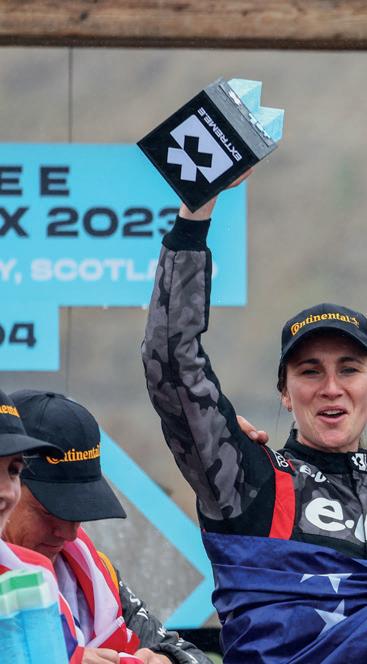


EXTREME E 20
EXTREME E
After finishing the Season 2 Finale as the fastest qualifiers, Veloce Racing maintained their upward momentum at the start of 2023 by taking their debut win in Extreme E.

Kevin Hansen and Molly Taylor were immediately on the pace in the sands of Saudi Arabia, winning the opening round of Season 3 at the Desert X Prix in NEOM, Saudi Arabia. They were joined on the podium by ACCIONA | SAINZ XE Team (ASXE) and Season 1 champions Rosberg X Racing.
The same trio were back on the podium for Round 2 in NEOM, although it was Spanish outfit ASXE who picked up their maiden victory in Extreme E.


New driver pairing Laia Sanz and Mattias Ekström, the latter replacing the injured Carlos Sainz Snr., were on the pace throughout the weekend with a first win just rewards, with Veloce Racing and RXR second and third.
The series visited Scotland for the first time for Rounds 3 and 4, with the Hydro X Prix course and backdrop one of the most dramatic on the calendar so far.
All eyes were on Andretti Altawkilat’s Catie Munnings at the team’s home event, and it looked like they would take their first win since the 2021 Arctic X Prix as Munnings crossed the finish line in first. However, an earlier penalty awarded to Andretti Altawkilat demoted them to second, allowing Season 2 champions X44 Vida Carbon Racing to take their first win of the campaign. Carl Cox Motorsport also took their first-ever Extreme E podium at the team’s home event.
Round 4 of the championship saw the first double-winner of the campaign, as Veloce Racing took home the honours in the second part of the Hydro X Prix double-header.

A charging NEOM McLaren Extreme E team finished second to take their first podium of the campaign, while in third were No. 99 GMC Hummer EV Chip Ganassi Racing’s new driver pairing of Amanda Sorensen and RJ Anderson.

Fourth and fifth in the Round 4 Grand Final were ASXE and RXR after colliding in the race, giving Veloce Racing a further boost following their second win of the campaign as the team claimed the championship lead. Both teams, though, were back on song at the Island X Prix in Sardinia, co-organised and coordinated by the Automobile Club d’Italia and Regione Sardegna. Nico Rosberg’s RXR outfit took two wins in Rounds 5 and 6, while ASXE returned to the top of the Season 3 standings after a strong showing on the Italian island. In each event Sanz and Ekström trailed the superlative pairing of Johan Kristoffersson and Mikaela Åhlin-Kottulinsky for RXR, with both teams leapfrogging Veloce Racing in the standings after the British outfit finished sixth and seventh, respectively, in Italy.
In Round 5, No. 99 GMC Hummer EV Chip Ganassi Racing made it back-to-back podiums as they finished third. It could have been so much more for the team after finishing first on the course, but a penalty applied post-race dropped them down the order.
No. 99 GMC Hummer EV Chip Ganassi Racing trailed RXR and ASXE in Round 6 and were so close to making it three podium finishes in a row, but they were pipped at the final corner by Andretti Altawkilat’s Munnings who snatched third place.
RXR became the first team to win both races at an X Prix so far this season, closing the gap to the new championship leaders ASXE to four points.
With just 14 points separating the top three with four Rounds remaining, Extreme E Season’s championship battle is all set to be closer than ever.
21
Copy and images courtesy of Extreme E.
THE ALL-NEW VOLKSWAGEN ID.3
Last month, Volkswagen launched its brand new, upgraded ID.3 and here is everything you need to know about it.
Volkswagen unveiled the ID. brand back in 2019 when it showcased its first fully electric MEB based vehicle, the original ID.3, at the Frankfurt Motor Show, with customer deliveries beginning early next year.
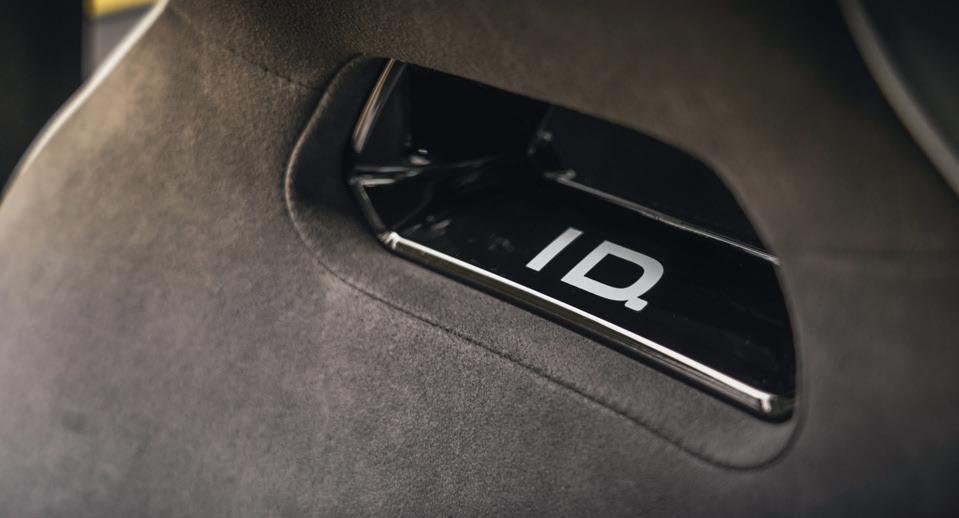
Since then, the automaker has become one of the biggest players in the electric vehicle market, with the likes of the ID.4, the ID.5 and the ID.Buzz, all of which have been reviewed on the EV Powered YouTube channel.
Volkswagen has plans to release ten new e-models by 2026, and that begins with an upgraded ID.3 model.
It is the second coming of the ID.3, which was originally named to signify the three generations of VW (the air cooled Beetle, water cooled Golf, and then the new era of electrification).
So, why has Volkswagen decided to upgrade the ID.3? And what can we expect?
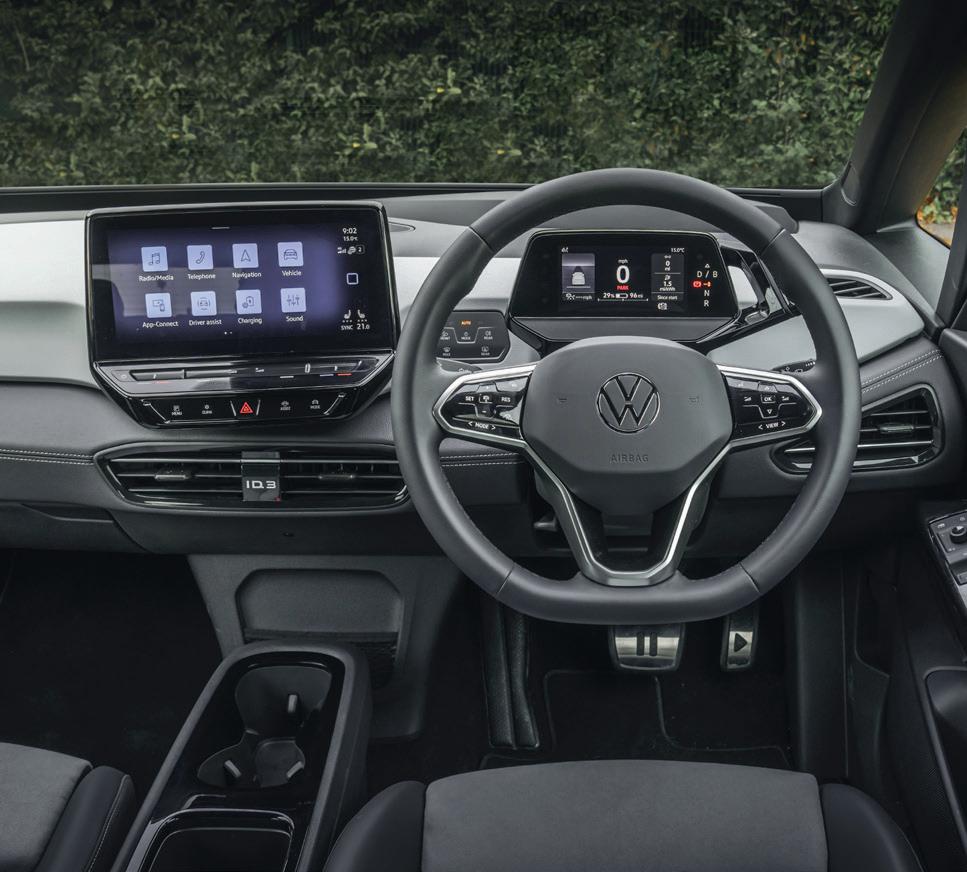
Back by popular demand
Volkswagen Group has increased all-electric deliveries by 48% in H1 2023 globally, with 321,600 BEVs handed to customers in 2023 vs 217,200 in the same period in 2022.
Europe had the strongest growth, with an increase of 68% year-onyear to 217,100 BEVs. In terms of the most popular models, the ID.4 and ID.5 were the most successful Volkswagen BEV models in H1 2023 with 101,200 sales.
However, despite being the oldest model in its lineup, the ID.3 is the second most successful BEV model within the Group, selling 49,800 units.
Across the wider electric vehicle market, there is demand for smaller, more affordable electric vehicles as well, with the likes of the MG4 EV, the Fiat 500e, and a whole host of other models entering the sector.


The market had become saturated with SUVs and crossovers, as can been seen with Volkswagen’s ID.4, ID.5 and ID.7 models, but the brand seems to be adapting to the new trend in the industry with the re-release of the ID.3.
ID.3 in-depth
Volkswagen’s 2023 ID.3 will be available in Pro (58 kWh) and Pro S (77 kWh) model trims, with a few tweaks to the exterior design and a revamped interior.
The Pro S model will feature a range of 347 miles and the same motor and battery configuration as before, with a 204hp motor driving the rear wheels, delivering 310NM torque and a 0-62mph time of 7.9 seconds with the Pro S.
The cars design has been given a more ‘grown up’ feeling, with Volkswagen removing the decals on the side, with a sharper bonnet design and a new bumper with ‘air curtains’ to improve aerodynamics.
The ID.3’s interior has been revamped with a newly designed dashboard as standard, with a 10-inch infotainment display. The software for displays has also been updated, which should improve operational performance as previous ID. models had been guilty of ‘laggy’ screens.
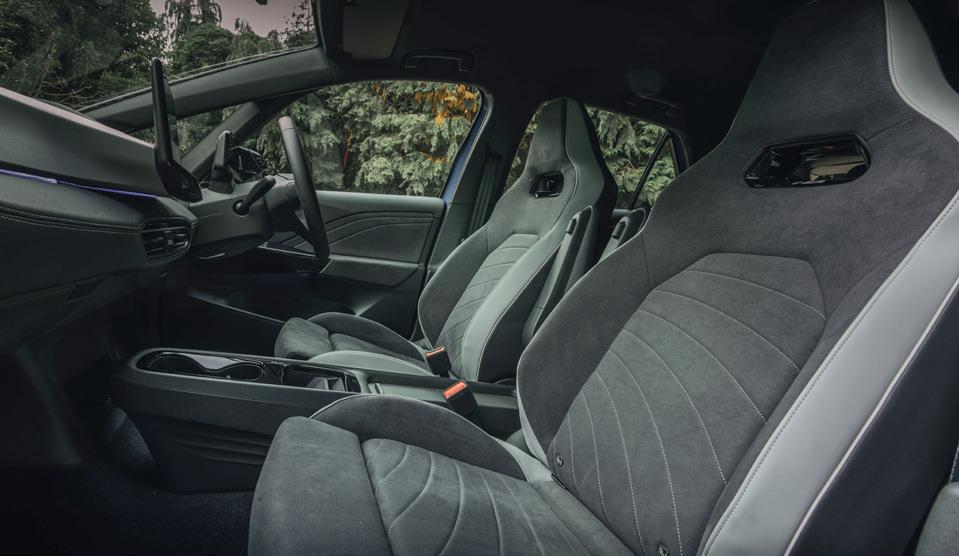
VOLKSWAGEN ID.3 22
VOLKSWAGEN ID.3
An optional AR head-up display will also be available, along with Travel Assist with swarm data and Park Assist Plus with a memory function.
The standard ID.3 will come kitted out, however, with an adaptive cruise control system, LKED headlights with beam assist and ErgoActive design seats.
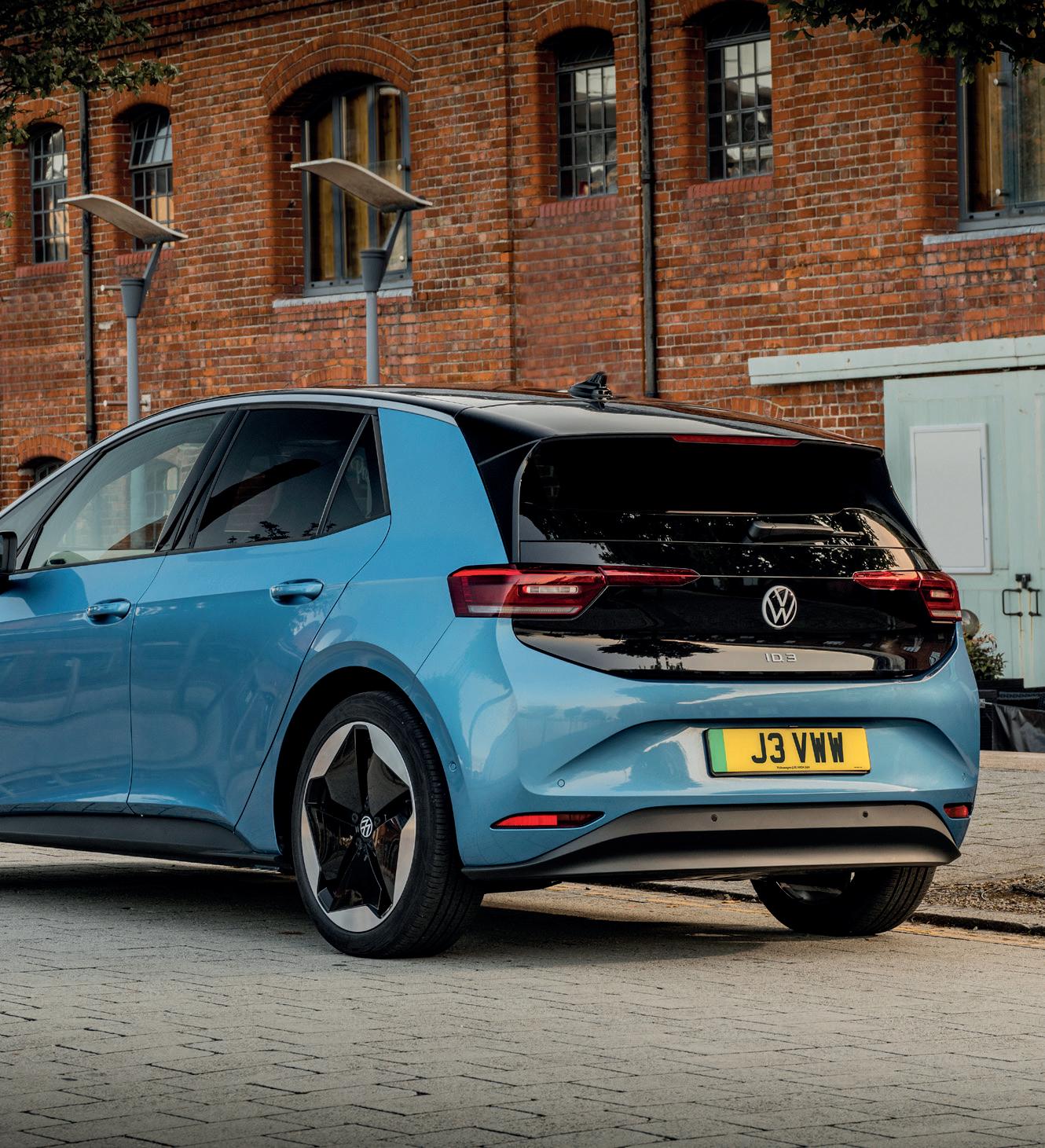

In terms of the furnishings, 71% of materials inside the car are recycled, with foam cushioned surfaces giving the car a more premium feel. There is also an option for a large glass panel that stretches over the entire width of the roof, with tinted glass and a sun blind.
The ID.3 will also be bi-directional charging ready, with a charging capacity of up to 170kW. The new ID. 3 01 also offers Plug & Charge capability. This makes charging at quick-charging stations or at home even more convenient as the vehicle registers itself at a charging station with the Plug & Charge function and activates the station – the charging process then starts automatically.
Pricing
Prices for the new Volkswagen ID.3 start from £37,115 for the Pro spec, with prices rising to £42,870 for the Pro S.
Head-to-head, the Pro S has a greater range, offering an WLTP-official 347 miles in comparison to the Pro’s 266 mile range.
Both models come with High Beam Assist, automatic sensing for switching between dipped and main beam; Wireless smartphone charger; 10 colour ambient lighting;
Remote electrically foldable door mirrors, puddle lights and reverse activated passenger’s door mirror.
NEW ID.3 SUMMARY
Exterior
• Sharper design
• New bonnet and bumper
• Newly designed exterior details
Interior
• Improved look and feel
• Zero animal materials
• Recycled materials
Technology
• Latest software
• Smart charging functions
• Enhanced driver assistance systems
Range Up to 347 miles
Performance 204hp | 0-62mph: 7.9 sec
Price Starting from £37,115
23
CUBE NURIDE HYBRID EXC 625 ALLROAD:
A CITY RIDER’S DREAM
BY RICHARD ALVIN
The Cube Nuride Hybrid EXC 625 Allroad is specifically designed for the urban environment. Its comfortable sit-up frame, chunky pothole-proof tyres, and userfriendly components make it an ideal choice for daily commuting and city adventures.
What sets this bike apart is the addition of the Bosch Performance
CX electric bike motor and a generous 625Wh battery, which provide ample power and range for all your cross-city chores.

Frame and Specifications

The Cube Nuride Hybrid EXC 625 Allroad features a hydroformed alloy frame with three options to choose from. You can opt for a traditional top tube, a dropped top tube, or an ‘Easy Access’ model with a stiff down tube and no top tube at all. The down tube cleverly conceals the large 625Wh battery and merges seamlessly into the housing for the Bosch Performance CX motor around the bottom bracket. At the front, you’ll find an air-sprung X-Fusion MIG32 fork with 100mm of travel. This fork allows for easy tuning to accommodate different rider weights and provides a comfortable ride over bumps and potholes. It also features a lockout lever on the top for firming up the suspension when needed.
Comfort and Performance
One of the standout features of the Cube Nuride Hybrid EXC 625 Allroad is its emphasis on

A Comfortable and Confident Ride
comfort. The bike boasts a thickly padded, wide Cube saddle on top of a suspension seatpost, which effectively absorbs bumps in the road for a smooth and comfortable ride. The wide Schwalbe G-One Allround tyres offer ample grip on cindered bike paths and occasional off-road excursions.

Equipped with a full Shimano Deore 12-speed drivetrain, the Cube Nuride Hybrid EXC 625 Allroad provides a wide range of gears for tackling various terrains. Shifting under load is impressively smooth and precise, thanks to the high-quality Shimano components. The nonseries MT200 brakes may not be fancy, but they do a decent job of bringing you to a stop with their long, comfortable levers.
Geometry and Ride Impressions
The Cube Nuride Hybrid EXC 625 Allroad’s geometry is geared towards comfort and stability, making it a joy to ride through city streets. The reasonably slack 67.5-degree head angle and the upright position, achieved through a highrise stem and riser bars, ensure a commanding view of the road and help you spot any potential obstacles ahead. It handles with calmness and confidence, even when faced with challenging urban environments.
My overall impression of the Cube Nuride Hybrid EXC 625 Allroad is that it offers unparalleled comfort and confidence when navigating city streets. The upright seated position provides excellent visibility, while the wide tyres, suspension fork, and suspension seatpost work together to absorb road imperfections and provide a smooth ride. Whether you’re commuting to work or running errands around town, this bike is more than capable of getting you there comfortably.
Fine-Tuned for Urban Adventures
The Cube Nuride Hybrid EXC 625 Allroad is finely tuned to handle the demands of urban riding. The suspension fork effectively takes the sting out of lumps and bumps, ensuring a comfortable ride. The Schwalbe G-One Allround tyres, with their generous width and dimpled tread pattern, offer ample grip on different surfaces, from cindered bike paths to occasional dirt tracks.
Moreover, the bike’s Shimano Deore drivetrain performs flawlessly, providing a wide gear range and smooth shifting under load. The non-series MT200 brakes, though not the most high-end option, are comfortable to use and offer decent stopping power. These components work together harmoniously to deliver a reliable and enjoyable riding experience in the city.
Unique Handling Characteristics
While the Cube Nuride Hybrid EXC 625 Allroad excels in many areas, it does have some unique handling characteristics worth noting. The Alex EX23 rims,
E-BIKES 24
HYBRID ALLROAD:
though not particularly wide, support the Schwalbe G-One Allround tyres. However, the slightly pinched profile of the rims gives the tyres a pointed shape at the top. This can result in a quicker drop into turns and a hint of front-wheel flop, which may take some getting used to. Wider rims would alleviate this handling quirk and provide a smoother transition from central to edge treads.
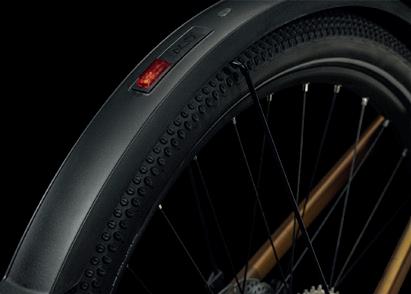
Additional Features and Considerations
Bosch Motor and Battery System
One of the standout features of the Cube Nuride Hybrid EXC 625 Allroad is its Bosch Performance CX electric bike motor and 625Wh battery. The motor offers four assistance modes, ranging from gentle support to full assistance for heavy loads or effortless cross-city travel. The central display provides essential information such as

battery level, speed, and assistance mode, while additional data can be accessed via the control unit mounted near the left-hand grip.


Thoughtful Finishing Touches
Cube has paid attention to the bike’s finishing touches, enhancing both functionality and convenience. The grips feature a broad palm pad, offering comfort and control as you navigate through traffic. Full mudguards come fitted as standard, ensuring a clean and dry ride even in wet conditions. The integrated rear light, controlled by the on-bar Bosch head unit, is small yet bright, while the front headlamp provides ample illumination. The inclusion of a kickstand adds practicality, making it stable on most surfaces.
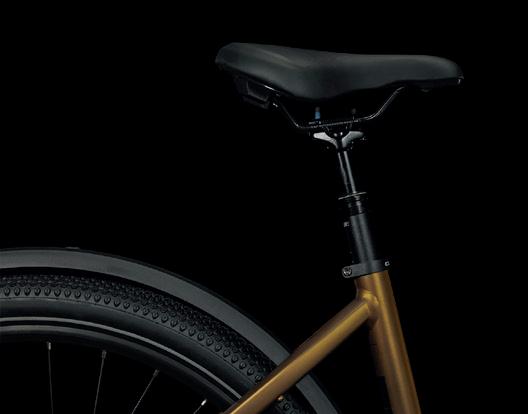

Personalization Options
While the Cube Nuride Hybrid EXC 625 Allroad comes with thoughtful features, it would have been even better if it included a rear rack. However, the frame has all the necessary bolt holes for attaching your own rack, allowing you to personalize the bike to suit your needs. The only minor flaw I found in the bike’s shape is the relatively high top tube, which can make it slightly challenging to swing a leg over when the bike is loaded.
Final Thoughts: A City Rider’s Dream
After spending time with the Cube Nuride Hybrid EXC 625 Allroad, I can confidently say that it is a city rider’s dream. Its comfortable and confident ride, combined with the power and range of the Bosch motor and battery system, make it an excellent choice for daily commuting and urban adventures. The bike’s emphasis on comfort, from the suspension fork and seatpost to the wide tyres, ensures a smooth and enjoyable ride, even over rough city streets.
While the unique handling characteristics take a bit of getting used to, the overall performance and reliability of the Cube Nuride Hybrid EXC 625 Allroad make it a standout option in the electric bike market. Whether you’re navigating crowded city streets or cruising along bike paths, this bike is sure to impress with its versatility and capability. So, if you’re in the market for a reliable and comfortable electric hybrid bike that can handle the challenges of city riding, look no further than the Cube Nuride Hybrid EXC 625 Allroad. It truly is a city rider’s dream come true.
25 E-BIKES DREAM
WHAT’S NEW? WHAT’S NEW? MONTEREY CAR WEEK SPECIAL!
LAMBORGHINI DEBUTS THE FULLY-ELECTRIC LANZADOR! AUTOMOBILI PININFARINA’S ELECTRIC HYPER


Automobili Pininfarina has unveiled the world’s first pure-electric, open top hyper Barchetta – the breathtaking new B95.
The B95 made its world premiere at Monterey Car Week in August, presented alongside the Battista Edizione Nino Farina hyper GT, which debuted at Goodwood Festival of Speed in July, as well as the recently launched PURA Vision design concept.
Automobili Pininfarina’s PURA design philosophy expresses an elegant silhouette and dramatic proportions. The principles established here have been translated for B95, balancing inspiration from iconic classic race cars with futuristic elements, all while remaining true to the PURA philosophy.
Lamborghini chose Monterey Car Week to unveil the Lanzador, a fully-electric concept car planned for 2028.
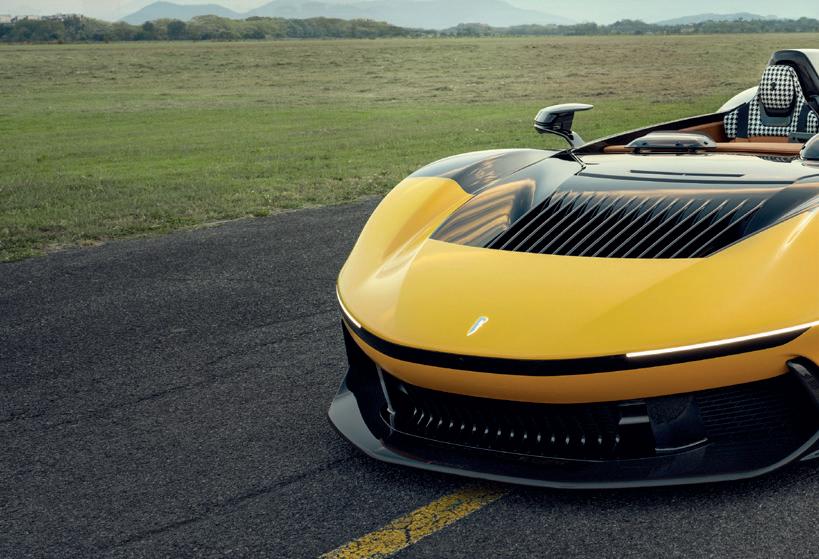
As part of the brand’s Direzione Cor Tauri strategy, this concept marks a significant step towards the decarbonization and electrification announced in 2021.
With an innovative Gran Turismo 2+2 concept, the Lanzador is equipped with two electric motors, one for each axle, providing all-wheel drive and efficiency in all driving conditions, on all surfaces, and in every driving style. The system delivers a peak power that exceeds one megawatt.
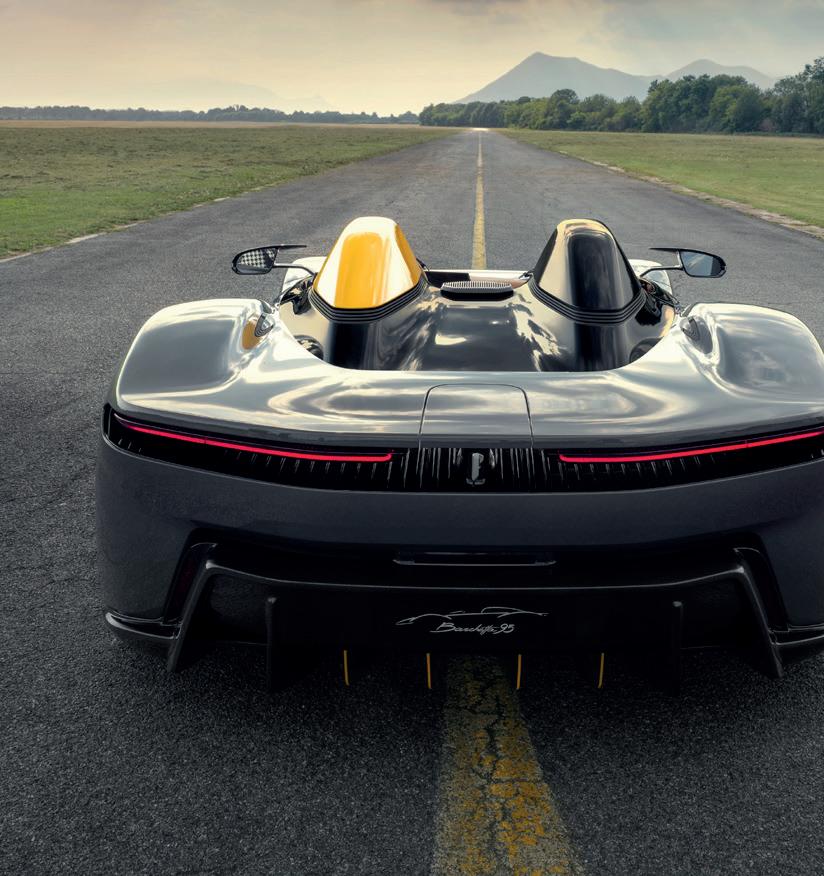
The driver can independently adjust the control systems while on the road via controls on the
sports steering wheel, actively modifying the car’s behavior and creating their own individual profile.
The new version of the driving dynamics control system, Lamborghini Dinamica Veicolo Integrata (LDVI), will give drivers freedom of customization, allowing them to modulate the active control systems to best suit their driving needs.
Active Aerodynamics is another key feature of the Lanzador, employed in the front and rear to maximize aerodynamic efficiency in the different driving modes. This technology enables the car to regulate airflow precisely, increasing the range in Urban mode and increasing downforce in Performance mode.
Handcrafting and deliveries will begin in 2025, marking the 95th B95 the anniversary of Pininfarina SpA. The ‘B’ in its name stands for Barchetta, both elements combined creating the name Automobili Pininfarina B95.

WHAT’S NEW?
PININFARINA’S B95 IS THE WORLD’S FIRST HYPER BARCHETTA
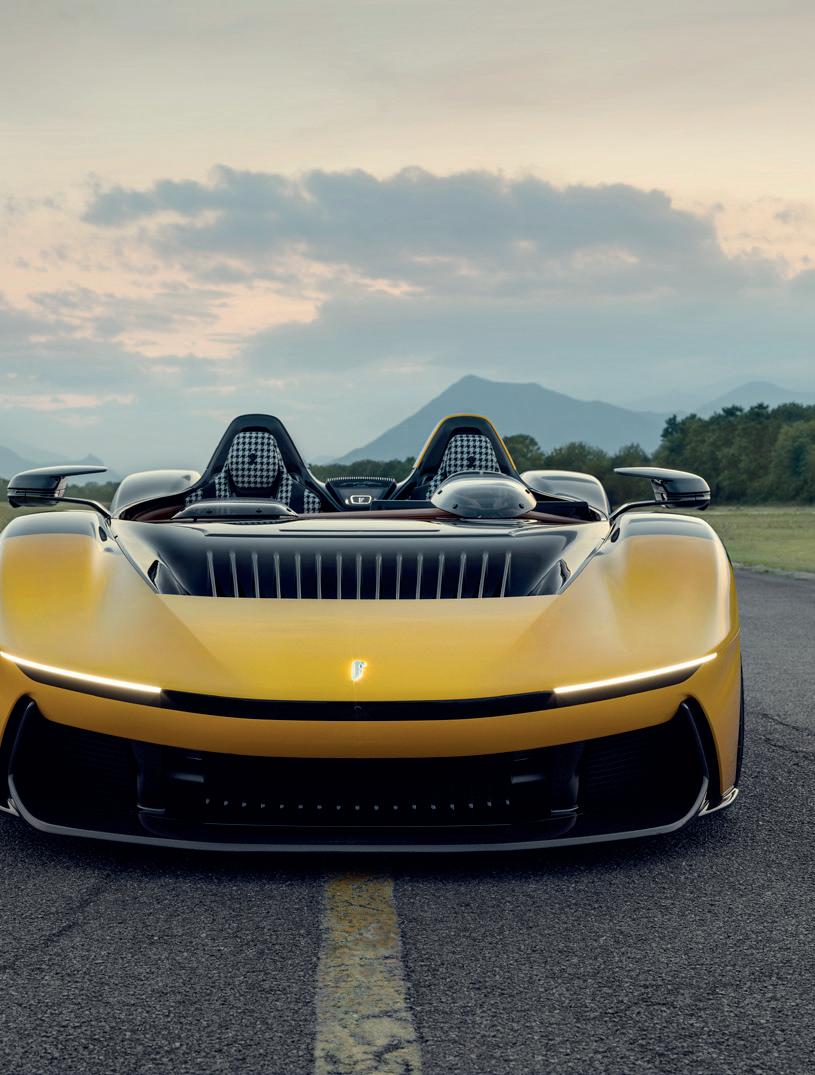

EVERRATI UNVEILS ELECTRIC PORSCHE 911 (964) AT PEBBLE BEACH
Just ten examples will be made, each one meticulously curated between the Automobili Pininfarina design team in Cambiano and individual clients, ensuring complete exclusivity as no two will be the same.

Paolo Dellachà, Chief Executive Officer, Automobili Pininfarina, said: “This is the most exciting chapter of the Automobili Pininfarina story so far – we’re taking another big step forward. B95 delivers the power of Battista and yet creates a new dimension of driving experience, redefining the very joy of driving. It is the first of a new kind, an object of desire that introduces the thrill of exceptional, electrified performance in stunning open-top form.”
Electrification specialists Everrati showcased an electric 911 (964) and 911 S 1970 at Monterey Car Week.
Everrati’s redefined electric 911 (964) is one of the company’s first US builds, commissioned by its high profile sustainable-tech entrepreneur owner and hand-crafted by Everrati’s partner Aria Group in California.
Its display also featured the first formal public showing of its redefined Mexico Blue 911 wide body redefined by Everrati, plus a Concours legend in the 911 S 1970 – a car that has previously wowed crowds at Pebble Beach, taking second place in its class in 2013.

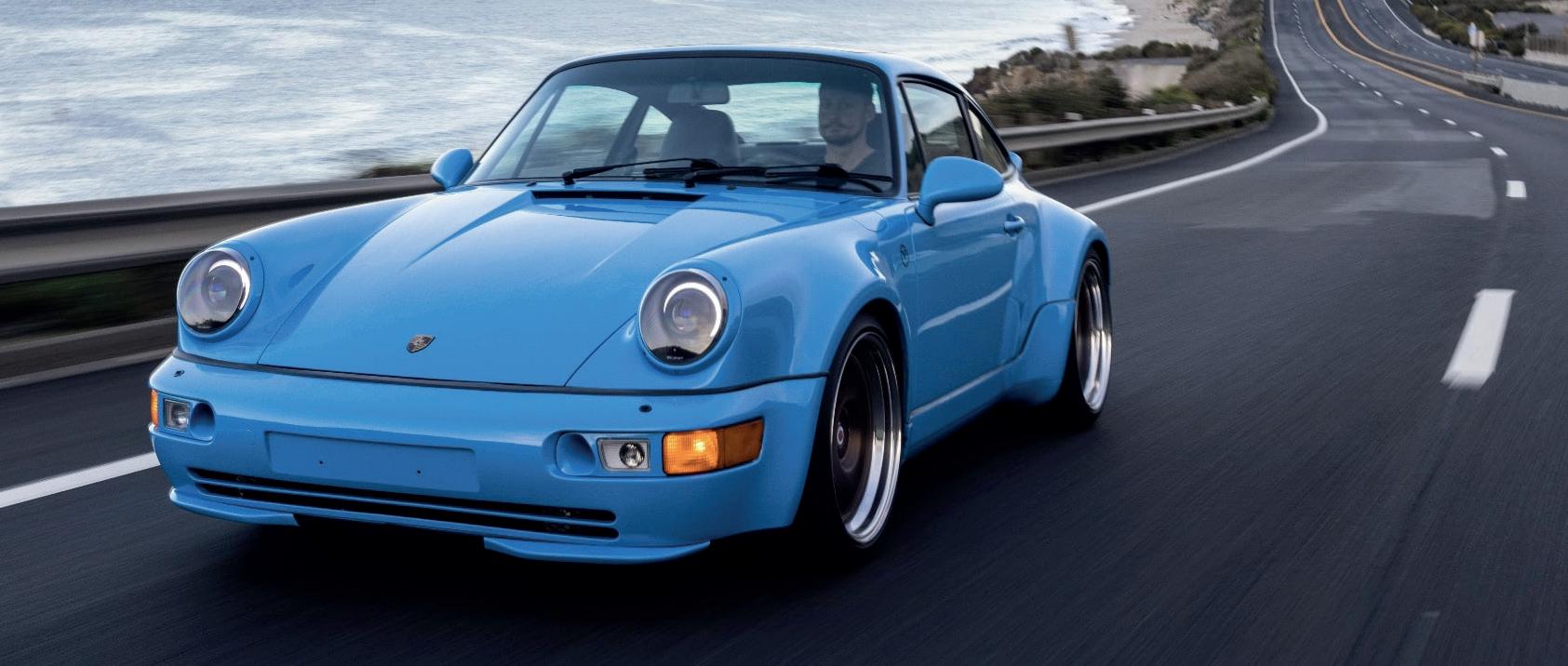
Justin Lunny, Everrati co-founder and CEO, said: “Pebble Beach is renowned as the centre of the motoring universe each August. We are very proud
to showcase our stunning redefined electric Porsche 911 alongside the rare and wonderful 911 S. These vehicles represent two very different eras of Porsche and powertrain technology and are a perfect celebration to mark the 75th anniversary of 911.

“The car is the result of our meticulously hand-built, OEM-grade processes and dedication to detail, from the engineering of its bespoke electric powertrain all the way to its luxurious bespoke interior, which we pride on preserving the soul and character of each car.”
Everrati showcased the car at Pebble Beach to honour Porsche’s 75th anniversary of the 911. This special 911 is a homage to the new Porsche 911 S/T announced by Porsche, as well as Everrati’s own inspired electric Porsche ST which it recently announced will join its portfolio.
27
NEW?
NEW?
Take a look at some of the new cars and concepts that were unveil last month during Monterey Car Week, including a fully-electric Lamborghini!
SPECIAL!
TEN MOST FORMULA E’S

MOMENTS FROM UNFORGETTABLE
With Season 9 of the ABB FIA Formula E World Championship finished, we look back over the past 16 races to determine the ten most unforgettable moments!
DENNIS WINS FIRST RACE OF GEN3 ERA
All the way back at the start of the year, Avalanche Andretti’s Jake Dennis kicked off the new era of Formula E with a stunning victory in front of 40,000 ultrapassionate Mexican fans. Dennis delivered an energy management masterclass to kick his season off in the best possible way, and the result was one of just two wins for the British driver throughout the season as he went on to win his first World Championship in Formula E.

TOP TEN 28
FROM UNFORGETTABLE SEASON 9!
In February, Nissan’s Sacha Fenestraz sealed his first Julius Baer Pole Position for the inaugural Cape Town E-Prix and set Formula E’s fastestever lap in the process.


Fenestraz beat the time of Maserati MSG Racing’s Maximilian Guenther by over four tenths of-asecond to set a stunning time of 1m07.848s - the fastest lap of the day and with an average speed of 154.987km/h, the fastest lap in Formula E history.
ROOKIE FENESTRAZ LANDS FIRST FE POLE WITH FASTEST-EVER LAP
Fenestraz was unable to capitalize on his first ever pole, however, as he failed to finish and had to settle for just three points for the pole position and a place in the record books.
29 TOP TEN
There are fine margins in Formula E and sometimes drivers do come into contact with each other, but the worst possible scenario is crashing into your own teammate.
Unfortuantely for Jaguar’s Sam Bird, that is exactly what happened in the first round of the Jakarta double-header, when the Brit tapped the rear of Mitch Evans’ car, sending the championship contender into a spin and into the barriers, eventually forcing him to retire. It was the second time the Brit has broken the golden rule of racing - never hit your teammate - as he made the same mistake in Hyderabad when misjudging his entry into ATTACK MODE earlier this year!
SAM BIRD TAKES OUT HIS TEAMMATE
GUENTHER FLIES TO CONSECUTIVE POLES IN JAKARTA

After waiting 60 races to get his first Julius Baer Pole Position, Maximilian Guenther of Maserati MSG Racing managed to secure two back-to-back after another dominant performance during the Gulavit Jakarta E-Prix qualifying. Guenther was on fire all morning, topping every single timed session and carrying his Round 10 form into Round 11. Guenther would go on to secure a third-place finish on the Saturday before claiming Maserati’s first victory in Formula E on the Sunday.

FORMULA E TOUCHES DOWN IN INDIA
There were a number of new venues and locations this year for Formula E’s most expansive season yet, and one of the most vibrant destinations on the calendar was Hyderabad, India! Driver’s had to battle intense conditions throughout a challenging weekend and it was DS Penske’s Jean-Éric Vergne that came out on top, claiming his one and only win of the season! The race also delivered a boost to the local economy as well, with a report conducted by Nielsen Sports Analysis finding an $83.7 million uplift to the Hyderabad economy as a result of Formula E’s Indian debut!

As the fight for the World Championship got into full swing, Envision’s Nick Cassidy laid down a signal of intent with a storming drive from ninth on the grid to win the Monaco E-Prix. Arguably one of the tightest and most challenging circuits on the calendar, Cassidy surged through the order to eventually claim his spot out in front and also at the top of the Drivers’ Standings. The victory gave Cassidy a 21-point advantage over Wehrlein, with Dennis and Evans further back, but the Kiwi couldn’t hold onto his spot and eventually finished second behind Jake Dennis.

CASSIDY LEADS THE WAY AFTER MONACO VICTORY
Jaguar TCS Racing played a blinder with their race strategy to seal a Mitch Evans, Sam Bird one-two in a beautifully chaotic SABIC Berlin E-Prix Round 7 that saw 190 overtakes and a record 20 at-theline lead changes and eight different race leaders. The one-two in Berlin followed a onetwo-three for the Jaguar powertrain in São Paulo, as Mitch Evans led home Envision’s Nick Cassidy and teammate Sam Bird, with the trio just half a second apart!
JAGUAR TAKES MAIDEN FORMULA E ONE-TWO IN BERLIN

HUGE CRASH ON THE STREETS OF ROME
In a race which saw Mitch Evans end the curse of not being able to win from the Julius Baer Pole Position in Rome, another story dominated. On lap 10, a high-speed crash wiped out several drivers, all of which were unhurt in the multicar shunt. The start of the incident was initiated by the Jaguar of Sam Bird, who lost control of the rear of his car out of the rapid Turn 6. Bird was stranded in a vulnerable position, when Envision Racing’s Sebastien Buemi made contact with the back of his car, which launched Buemi up and into the wall at an angle before he landed back down. In the chaos, several cars all clipped their cars on that of Buemi or Bird. Seconds later, the Maserati MSG Racing of Edoardo Mortara hit into the side of Bird and understandably the race was immediately red flagged. After the 45 minute red flag period, only 13 drivers were able to continue in the scorching Italian heat before taking to the restart and finishing the full race distance.
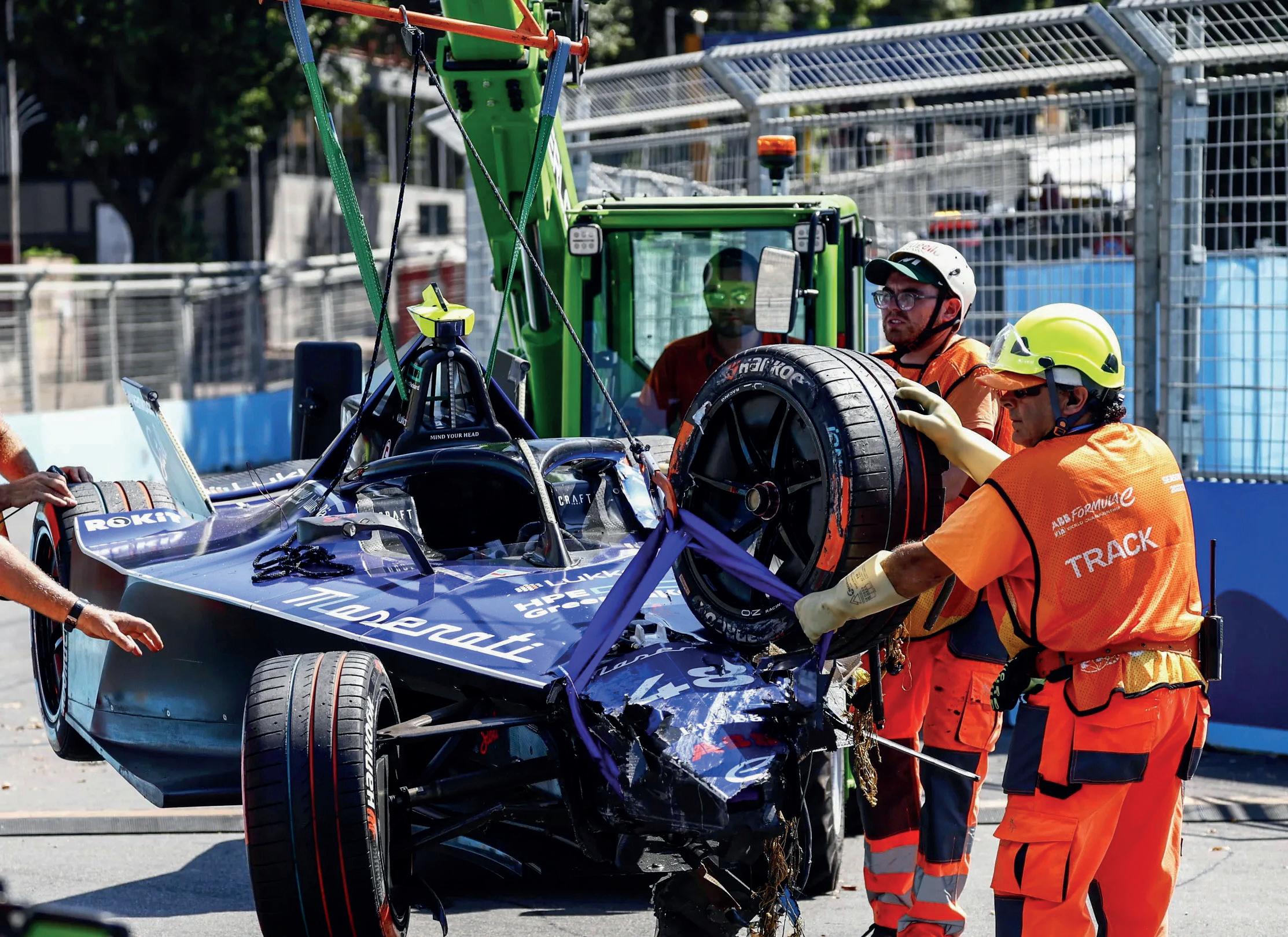
DENNIS WINS HIS FIRST FORMULA E WORLD CHAMPIONSHIP
After a season of twists and turns, it was Avalanche Andretti’s Jake Dennis that claimed the Season 9 World Championship following a dramatic opening race of the London E-Prix double-header. With Cassidy leading the grid, Jake Dennis needed a six-point swing to clinch his first Formula E title, but disaster struck for Cassidy when damage to his front wing forced him to retire from the race. With Cassidy out, Dennis only needed a third-place finish, and despite two red flags throughout the latter stages of the race, Dennis kept his nerve to bring the title home, becoming the first British Formula E World Champion.

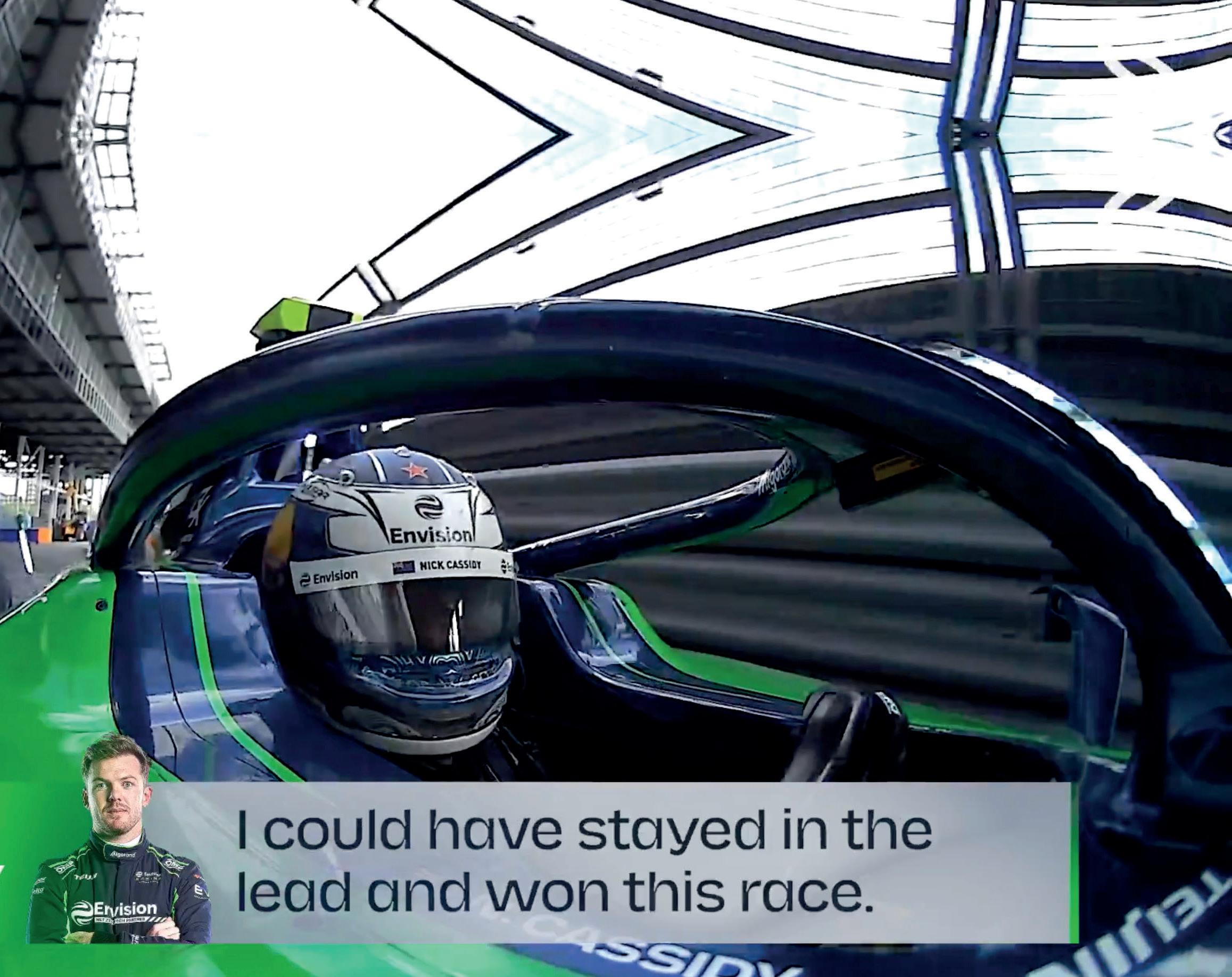
CASSIDY’S TITLE HEARTBREAK CAUSES EPIC OUTBURST
As the Kiwi pulled into the pit lane and retired from the race in London, the title was all but confirmed for Jake Dennis. It was delight for Dennis but despair for Cassidy, who vented his frustration to his engineers over the team radio, claiming: “You know what the funniest thing is, man? I didn’t even need to give up the lead; I could have stayed in the lead and won this race. I tried to do the right thing for the team. I did the right thing for the team because that’s what I’ve done all year.” The broadcasting cameras followed Cassidy into the garage and he couldn’t keep his cool, asking them for space. Shortly after, the cameras peered round the corner into the Envision technical area to find Cassidy berating his team, and once he had realized he was being filmed once again, the Kiwi stormed over and ordered the cameras away. Tensions were high, but Cassidy kept his cool the next day, claiming the final race win of the season, although it was ultimately too little too late.
WOULD YOU PAY FOR A BAY ?
A study of over 1,000 UK EV drivers by SMS explores the current customer experience of using, and relying on, public EV charge points. Despite an almost ubiquitous love of their EV (94 per cent), 67 per cent of UK EV drivers wish they’d known more about public EV charging availability before they’d transitioned to electric.
It found that over a quarter (27 per cent) are willing to part with up to £10, and 33 per cent up to £5. A further 7 per cent would even be prepared to go higher at over £10, all to avoid ‘charge anxiety’.
It uncovers that although we’re seeing an exponential growth in the home EV charging market, a mere 5 per cent of respondents rely solely on this option to power their vehicle. In reality, a fifth (20 per cent) of EV drivers surveyed remain completely
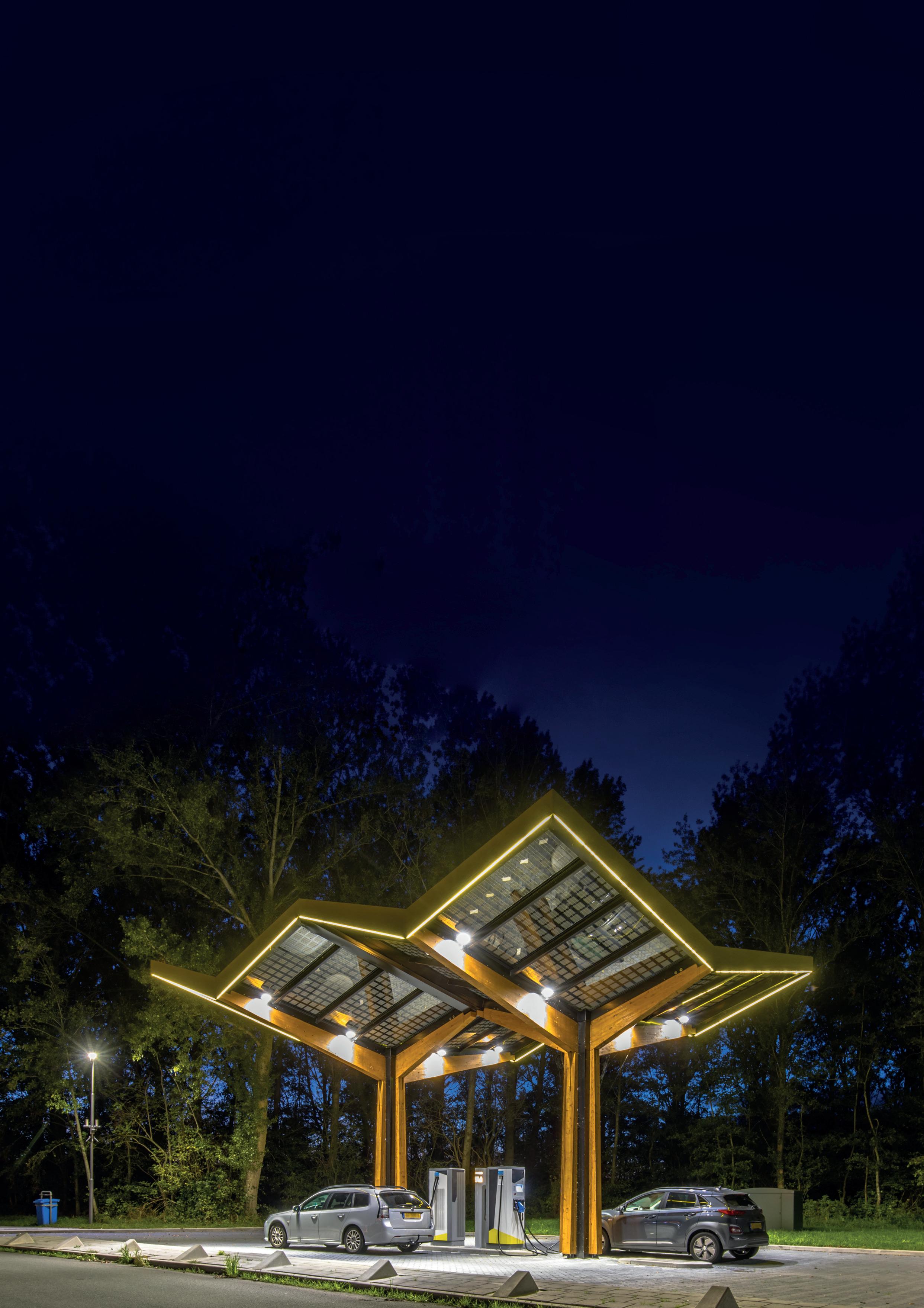
reliant on public EV charging due to having no charge points available to them at home or at work. A further 33 per cent use public EV charge points a lot, with 31 per cent only sometimes, and only 15 per cent stated ‘rarely’.
Surprisingly, 70 per cent of EV drivers still have limited public charging options in their area. This leads to a staggering 81 per cent of EV drivers having to wait for a public charge point, with a third spending 30 mins to an hour (30 per cent), and 27 per cent between one to two hours before they could charge.
Mark Winn, Head of EV Strategy at SMS explained: “Home EV charging may be on the rise, but it’s critical that the UK’s growing number of EV drivers have adequate access to fully functioning public EV charge points while they are on the move. However, in the race to meet EV charging
expectations, targets and market share, companies have deployed –and continue to install – the wrong type of chargers, in the wrong location. Added to this, the payment options are either substandard or created to monopolise the market, and infrastructure maintenance
seems to be firmly off the ‘to-do’ list. This is creating a ‘perfect storm’ of customer dissatisfaction, frustration and charge anxiety for EV drivers, and the future of electric motoring in the UK is coming under unfair scrutiny as a result. We simply must do more.”
What else did SMS’ study uncover?
• Over three-quarters (77 per cent) have been unable or unwilling to access a public EV charge point. 36 per cent stated that this was because they are out of order / broken, and for 27 per cent it was simply that they weren’t available.
• An additional 18 per cent of EV drivers found the EV charge points were not compatible with their vehicle, and for 15 per cent they didn’t have their preferred payment option.
Worryingly, 17 per cent of respondents have avoided using public EV charge points because the location didn’t feel safe.
• 68 per cent of EV drivers admitted it is stressful to always have to think about public charging availability when they take a long journey.
EV RESEARCH 34
A new study has found that 67 per cent of EV drivers in the UK are prepared to pay a premium to reserve a public charging bay.
OPTIMISING
SYSTEMS FOR EVS HOME ENERGY

Thanks to the latest developments in eco-smart home energy technology, EV charging now forms just one part of an integrated system to optimise daily consumption. We spoke to Jordan Brompton, co-founder and CMO of myenergi, to find out more.
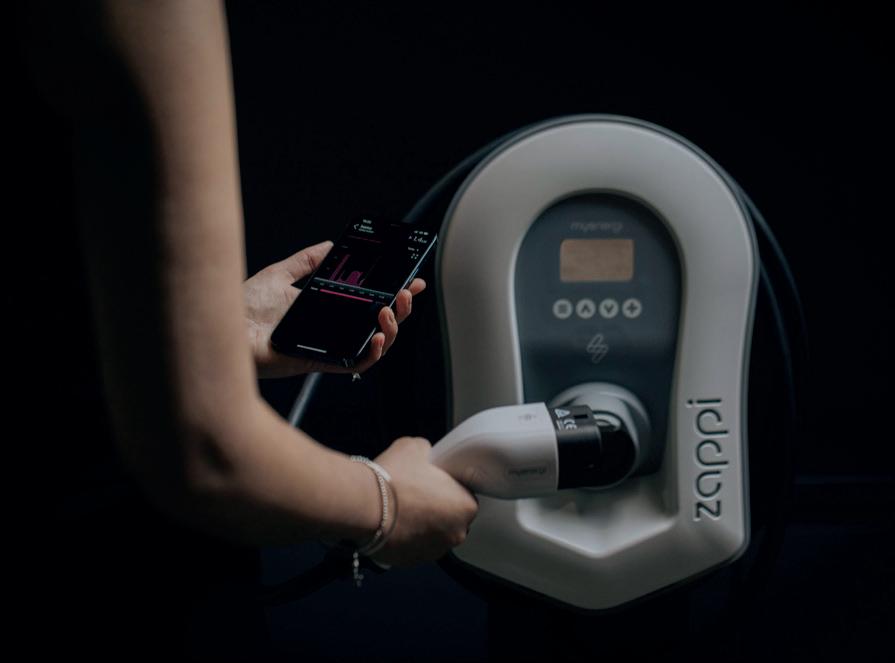

When it comes to accelerating the transition to electrification, the seamless integration of EV charging with our home energy systems is an interesting idea. While it may seem like an unusual concept, it’s important to view EV charging as just another element of home energy management, rather than an entirely separate activity, as it is with petrol and diesel vehicles. The idea of approaching these two systems together enables greater control and flexibility in energy consumption and management – particularly given the rise of ‘smart’ and ‘connected’ systems. From automated processes to scheduling high-energy activities with off-peak electricity rates, it can support our combined living and transport needs. It also enables intelligent and personalised energy optimisation, further helping to fight the climate crisis while reducing household expenses.
It is this approach that we have taken here at myenergi – providing the technology to enable a holistic strategy for generating, storing, and using energy at home. It all comes back to the concept of energy independence, reducing our reliance on the grid and increasing the consumption of renewables. Not only does self-generated energy, from sources like wind and solar, significantly lower a household’s carbon footprint, but it also reduces dependence on the grid to provide resilience against power outages and price volatility.
This is what motivated development of the myenergi zappi EV charger, a device capable of harnessing 100% self-generated green energy. Alongside zappi, we also manufacture eddi, a device designed to optimise the use of solar or wind energy. Rather than sending energy to the grid in periods of low demand, eddi diverts it to heating devices instead – providing free, low-carbon hot water and heating.
But what about energy storage? Well, that’s where libbi comes in; a modular battery storage system that captures and intelligently manages surplus energy based on household usage and electricity tariffs. All of these systems are modular, meaning you can use one, or multiple, with complete integration between them. Thanks to smart connectivity, each can be monitored and managed via the myenergi smartphone app, with real-time displays and graphs. As more householders begin to consider the possibilities of integrated home energy management, systems like ours allow them to maximise efficiency and take back control. Looking to the future, the amalgamation of personal transport and home energy could grow even closer, with EVs working as an energy storage system. Vehicle-to-grid and vehicle-to-home technologies will eventually offer the potential to temporarily run a home from an electric vehicle’s battery, or discharge vehicle energy back to the grid when demand is high. If implemented successfully and at scale, these systems could help reduce strain on the grid while further extending energy independence. By combining home and vehicle power systems, drivers can further optimise their energy consumption and carbon footprint for the benefit of the environment and the household budget. It highlights the notion that sustainability at the individual level can be transformed and enabled by interconnected and innovative technologies; an idea that we fully support. For more information about myenergi, or the company’s integrated ecosystem of home energy technologies, visit www.myenergi.com.
35 COLUMN
Want more control of your business budgeting?


This is Jasmin. She’s one of many business owners who already use a smart meter to feel more in control of their budgeting, because smart meters help you track your energy use and costs over time.
So like Jasmin, you can spend less time guessing and instead know how much you’re spending on your energy bills.
Search ‘get a smart meter’ today.
Eligibility may vary. Consumer action required. ALBERT EINSTEIN rights licensed by the H.U.J./BEN Group, Inc.
MAKING THE SWITCH: FROM GAS BOILERS TO AIR SOURCE HEAT PUMPS

THE ULTIMATE GUIDE TO TRANSITION
+ The latest news and updates for everything Electric Home


UK homes install ‘record number’ of SOLAR PANELS and HEAT PUMPS
A remarkable surge in green energy upgrades can be seen in UK households, setting new records in the installation of solar panels and heat pumps in the first six months of 2023, as per the industry’s official standards body.
In June alone, the industry witnessed more green energy installations than in any previous years. The figures indicate a consistent increase in the number of households opting for solar panels, with an average of over 17,000 installations each month. Heat pump installations have also hit a new high, with the rate surpassing 3,000 a month for the first time.
“As the cost of energy continues to grow, we are seeing more people turn to renewable technology to generate their own energy and heat at home.”Ian Rippin, Chief Executive of MCS 2023 has been a year of records for battery technologies, with installation figures consistently surpassing the month before. This led to more than 1,000 batteries installed across the UK, in homes and businesses alike, within the first half of the year.
The surge in green energy has put households on track to surpass the 2012 record of renewable energy installations, a year when many raced to install solar panels before government subsidies were reduced. Small-scale renewable energy installations across the UK now have a total capacity of 4 gigawatts (GW), outperforming Hinkley Point nuclear power plant under construction and almost doubling the capacity of Europe’s largest gas power plant near Pembroke in Wales.
The UK government has set ambitious targets to reach 70GW of solar capacity by 2035 and to install 600,000 heat pumps per year by 2028. Despite grants of up to £5,000 to lessen the cost of replacing old gas boilers, the uptake of heat pumps has fallen far behind the government’s ambitious aim.
In the first six months of 2023, there were 17,920 heat pump installations according to MCS data. If we project the same pace for the second half of the year, heat pump installations would reach only 6% of the government’s target.
“There is a tremendous job of work to do” to ensure that heat pump technology becomes mainstream over the remainder of this decade.”Bean Beanland, Director of External Affairs at the Heat Pump Federation
One of the significant challenges to achieving the government’s heat pump targets is the lack

of qualified, skilled installers who can provide trustworthy advice and installations. While the UK currently has 1,500 certified heat pump installation companies, an estimated 50,000 workers will be needed to meet the government’s targets.
Beanland further emphasized the necessity for the lowest-carbon heat to become the lowestcost heat. According to him, homeowners and landlords can justify the transition away from polluting fossil fuels only if it is coupled with genuine affordability and future funding packages.

NEWS 38
UK WINDFARM red tape to cost billpayers £1.5bn a year, say analysts
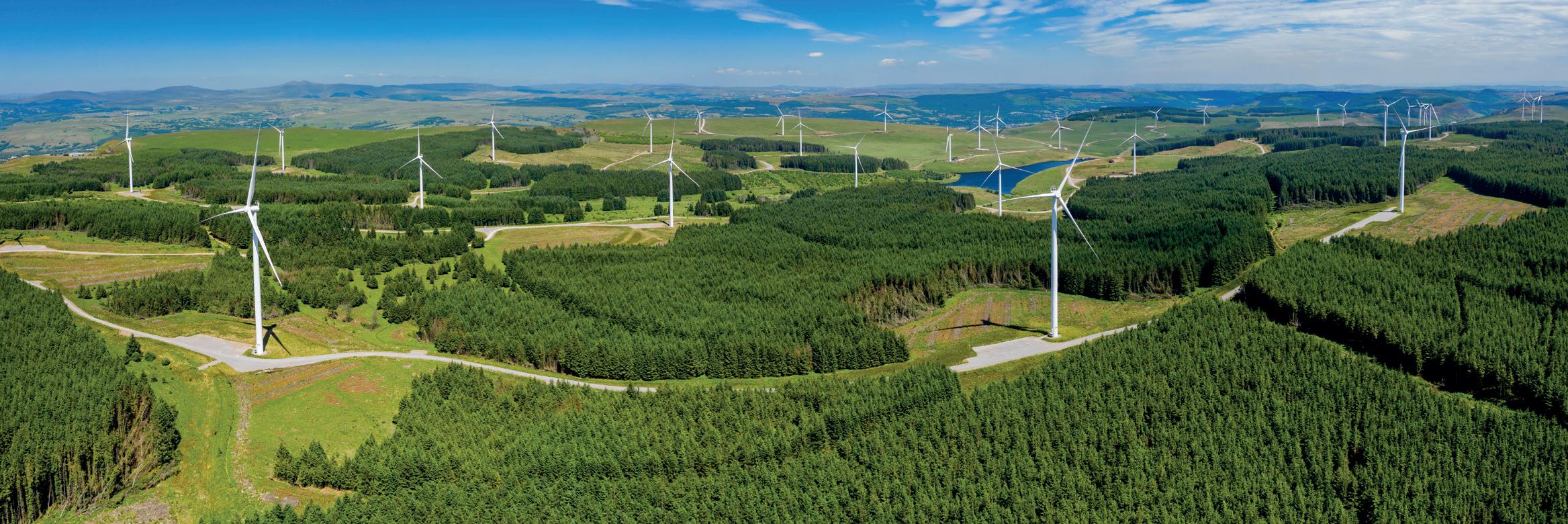
New offshore windfarms will be strangled by government red tape, costing UK billpayers £1.5bn a year, an analysis has found.
The latest government auction for new offshore windfarms, due to be completed in September, could result in few projects making it through Treasury rules, according to the Energy and Climate Intelligence Unit (ECIU), a non-profit organisation. Rules set by the Treasury do not take account of predictions that the gas price will stay high and put an arbitrary limit on the number of farms that can be contracted. They mean that the budget set in the government’s contracts for difference auction is unlikely to be spent, because many windfarms will not get through the auction, so bills will be kept higher.
Despite the fact that the government recently increased the budget for the auction from £170m to £190m, analysts at the ECIU said this was likely to make little difference to the outcome of the auction and ignored the fact that renewables were predicted to save customers money.

The previous auction round did not meet the budget and previous analysis found that 1GW of wind power was missed out on, along with savings of £225m a year. The ECIU found that the current auction could secure as little as about 2GW of offshore wind, leading to missed savings of more than £1.5bn a year from cheaper
renewable energy, compared with about 7GW that could have been secured.
Energy experts have criticised the government for giving tax breaks to oil companies and not allowing windfarms to thrive.
Jess Ralston, an energy analyst at the ECIU, said: “The government seems to be focused on North Sea gas licences and tax breaks for oil companies that won’t bring down bills, while tying up offshore wind farms that generate electricity cheaper than gas in red tape. What is going on?
“Even with inflation pushing costs up for offshore wind, it will still generate electricity much cheaper than gas power stations. Stifling windfarms pushes up bills. The Treasury’s rules seem to be actively working against bringing them down.”
If the rules around these auctions were not loosened, the ECIU said, it could put the goal of 50GW of offshore wind by 2030 at risk.
A spokesperson for the Department for Energy Security and Net Zero said: “We do not recognise these figures – last year’s Contracts for Difference scheme auction was the largest ever, issuing contracts to nearly 100 clean tech projects, and we increased this year’s budget to reflect the large volume of eligible applications received.
“The UK is a world leader in renewable technologies, with the four largest operational offshore wind farms in the world providing enough capacity to power the equivalent of at least 10 million homes per year.
“Contracts for Difference is designed to protect generators against price fluctuations, and compares favourably to other international schemes. We understand there are supply chain pressures for the sector globally, and we are listening to their concerns.”
One of Britain’s biggest boiler makers is to start manufacturing electric heat pumps to keep pace with what it describes as the biggest transformation since the switch from coal to gas devices in the 1930s.
Ideal Heating has invested £50m in transforming the manufacturing facilities at its Hull headquarters, which have produced fossil fuel boilers for more than a century.
As well as making about 500,000 gas boilers a year, the company will begin making thousands of heat pumps and invest in a “state-of-the-art” centre to train up to 5,000 staff a year to install and service them.
39 NEWS
ULTRA-HOT CARBON BATTERIES promise super-cheap heat and energy storage
Bill Gates-backed startup Antora Energy is preparing to roll out a containerized, modular heat battery, designed to store renewable energy at the lowest possible cost – then release it efficiently as electricity or industrial process heat.
It’s all in the name of decarbonizing heavy industry – a job that simply needs to be done, and a tricky one given the intermittent nature of renewable energy. It’s easy for factories to run 24/7 when there’s fossil fuel available to create heat as required, but what about when the Sun’s not shining?
Rondo’s “brick toaster” heat batteries, which propose a solution: use cheap renewable energy to heat up regular old clay bricks in insulated containers, then recover that energy as needed at about one-fifth the cost of a chemical battery, in the form of process heat at up to
1,500 °C (2,700 °F). Using cheap, abundant materials, Rondo hopes to deploy this solution at colossal scale, with no less of a goal than reducing global CO2 emissions by 15% within 15 years.

Antora believes its carbonbased system could be even cheaper and more useful. More useful both because it’s hotter, capable of delivering heat at upwards of 2,000 °C (3,632 °F), so it’s immediately relevant to huge industrial segments like steelmaking. And because the energy can also be recovered as electricity through super-efficient thermophotovoltaic panels.
Major UK gas boiler maker IDEAL HEATING to start electric heat pump production in Hull
The boilermaker expects to manufacture up to 60,000 heat pumps a year from the factory’s new production line, which could rise as forecast demand for heat pumps grows in the coming decades.

Shaun Edwards, the chief executive of Ideal Heating’s parent company, Groupe Atlantic, said the investments sent “a clear signal” about the company’s commitment to “remodelling our business to meet the needs of our customers today and into the future”.
“With the start of heat pump production and the many other investments we’re making, we’re now pushing strongly forward with renewable technologies that will play an ever-growing role in heating the UK’s homes and commercial premises,” Edwards said.

“The transition to low-carbon heating solutions including heat pumps is the biggest transformation in the business since we moved from coal to gasfired boilers in the 1930s,” he added.
The company’s support for heat pumps puts it at odds with many boilermakers who back an industry lobby group accused of trying to delay the take-up of heat pumps.
Lord Callanan, the minister for energy efficiency and green finance, visited the Hull factory on
Friday to mark the start of Ideal Heating’s heat pump production.
The government has set an ambitious target for 600,000 heat pumps to be installed in the UK every year by 2028, which will require thousands more skilled and qualified engineers.
NEWS 40
JAGUAR to repurpose used EV batteries for Northamptonshire energy storage system
Jaguar Land Rover (JLR) and Wykes Engineering are teaming up to develop
The two firms have announced today JLR is set to supply second-life batteries originally used for its Jaguar I-PACE electric vehicles (EVs) to renewables technology specialist Wykes Engineering, which then plans to slot these batteries into an energy storage system at a renewable energy part in Northamptonshire.
The battery storage system is to be spread across three locations at the Wykes-owned Chelveston renewable energy park, which boats over 85MW of installed wind and solar generation on site. The park is capable of producing 175,000MWh of electricity per year, which is enough to power more than 60,000 homes in the local area, according to JLR.
The batteries for the proposed facility have been taken from prototype and engineering test vehicles, with JLR hoping to supply enough batteries to store 7.5MWh of energy - enough to power 750 homes for a day - by the end of 2023.
According to JLR, batteries are simply removed from its Jaguar I-PACE and slotted into racks in containers on-site, with a single system housing 30 second-hand units and capable of storing up to 2.5MWh of energy at full capacity.
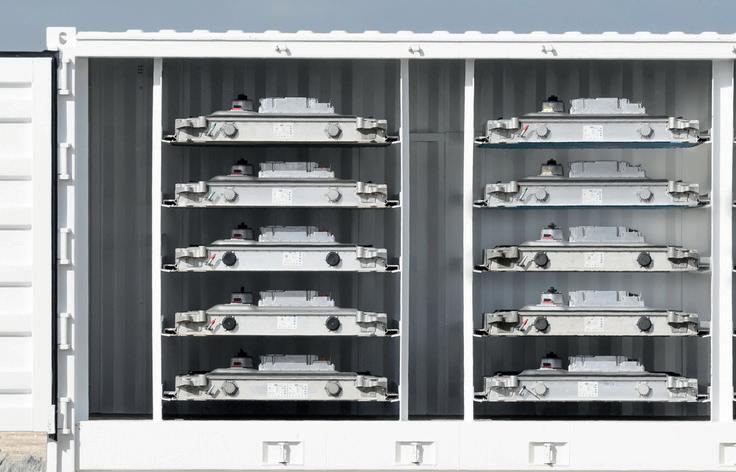
Moreover, each system is linked to an advanced inverter to maximise efficiency and manage energy, and is capable of supplying power direct to the grid during peak hours, in addition to drawing power out of the grid during off-peak hours to store for future use.
JLR said its second-life EV batteries were still able to be deployed in low-energy situations even after their performance falls below the stringent requirements of an electric vehicle, which typically still leaves a battery with as much as 80 per cent of its original capacity.
However, once the battery health falls below the required level for these second-life use cases, JLR said it planned to recycle the batteries to recover raw materials for re-use.
The partnership is designed to support JLR’s circular economy efforts as well as its ambition to achieve net zero emissions by 2039, according to François Dossa, executive director of strategy and sustainability at the automaker.
“Our sustainability approach addresses the entire value chain of our vehicles, including circularity of EV batteries,” Dossa explained. “Our EV batteries are engineered to the highest standards and this innovative project, in collaboration with Wykes Engineering, proves they can be safely reused for energy sector application to increase renewable energy opportunities. Using the 70 to 80 per cent residual capacity in EV batteries, before being recycled, demonstrates full adoption of circularity principles.
“Working together with industry-leading partners, we are developing a complete EV ecosystem, from batteries to charging, supporting our netzero transformation.”
According to McKinsey & Company research, second-life battery supply for stationary applications, such as renewable energy storage,

could exceed 200 gigawatt-hours per year by 2030, creating a over $30bn of economic value globally.
David Wykes, managing director of Wykes Engineering, added that the partnership with JLR could present a solution to potentially costly grid capacity issues.
“One of the major benefits of the system we’ve developed is that the containers are connected to the Grid in such a way that they can absorb solar energy, that could otherwise be lost when the grid reaches capacity,” he said. “This excess energy can now be stored in the second life I-PACE batteries and discharged later. This allows us to ‘overplant’ the solar park and maximise the amount of power we generate for the area of land we are using.”
The new follows last month’s announcement that JLR’s parent company Tata Group plans to build a flagship £4bn gigafactory in the UK - its first battery factory outside India - after months of negotiation with government to secure a major support package.
The new battery factory is reportedly earmarked for a site in Somerset and is expected to create around 4,000 UK jobs as well as thousands more across its supply chain, providing a major boost to the UK’s fledgling EV manufacturing industry.
The automaker has also recently set out plans to invest £15bn over the next five years in ramping up its electric vehicle offering, including through the production of its new all-electric Jaguar and Range Rover models at manufacturing sites in the UK.
41 NEWS
what they claim will be one of the UK’s largest energy storage systems made from old electric car batteries.
MAKING THE SWITCH: TRANSITIONING FROM GAS BOILERS TO AIR SOURCE HEAT PUMPS
For homeowners seeking to reduce their carbon footprint and find more energy-efficient solutions, the transition from traditional gas boilers to air source heat pumps (ASHPs) can be an attractive option.
With the UK government’s ambitious Net Zero Target by 2050, ASHPs are gaining popularity due to their sustainability and potential for lower energy bills.
In this comprehensive guide, we’ll delve into the world of ASHPs, offering valuable insights into their operation, types, pros and cons, costs, and how they compare to gas boilers. You’ll also find advice on preparing your home for an ASHP and the potential savings you could make.
ASHPs belong to the low-carbon technology family, offering an efficient heating and cooling solution for homes regardless of the climate. They generate electricity by harnessing energy from the outside air.
How do Air Source Heat Pumps work?

ASHPs operate by taking heat from the ambient air to warm your home. They can be used for both hot water and space heating. The heat from the outside air is absorbed into a loop containing a refrigerant fluid. Once the heat has been extracted from the air, it passes through a compressor, which raises the temperature. A heat exchanger then transfers the heat through pipes to the required locations like radiators, underfloor heating systems, hot water circuits, or air conditioners in the house.
Types of Air Source Heat Pumps

ASHPs come in two main types, distinguished by how they distribute their heat: via air or water.
AIR TO AIR HEAT PUMPS: These systems absorb heat from the outside air and then transfer it directly into your home through a fan system to heat a room.
AIR TO WATER HEAT PUMPS: These systems absorb heat from the outside air and then transfer it via your central heating system to provide hot water heating, radiator, or underfloor heating in an indoor space (or all three).
RENEWABLE ENERGY 42
RENEWABLE ENERGY
To determine the best ASHP for your home, we recommend consulting a professional heating engineer for an assessment and quote. Comparing quotes from multiple installers can help you secure the best installation deal.
ADVANTAGES and DISADVANTAGES of Air Source Heat Pumps
Like any technology, ASHPs come with their set of pros and cons. It’s crucial to be aware of these before making an investment.
ADVANTAGES of Air Source Heat Pumps

Here are the most significant benefits of purchasing an ASHP:
1. LOW CARBON FOOTPRINT
ASHPs emit low carbon emissions, making them an eco-friendly heating option.
2. COST SAVINGS
Transitioning to ASHPs can reduce your annual fuel bill significantly, especially for those switching from electric, coal, or LPG systems.
3. GOVERNMENT SCHEMES
The Boiler Upgrade Scheme offers a £5,000 voucher for the installation of ASHPs, promoting the adoption of low carbon heating technologies.
4. DUAL FUNCTIONALITY
Depending on the model, ASHPs can be used for both heating in the winter and cooling in the summer.
5. SPACE AND HOT WATER HEATING
An ASHP can also heat water if the flow temperature is around 55°C.
6. HIGH EFFICIENCY
ASHPs have a high seasonal coefficient of performance (SCOP), making them efficient in both winter and summer.
7. EASY INSTALLATION
ASHPs can be installed quickly without the need for digging like ground source heat pumps.
8. LOW MAINTENANCE
ASHPs require little maintenance and can be serviced annually by a qualified heating engineer.
9. LONG LIFESPAN
With proper maintenance, ASHPs can operate for up to 20-25 years.
10. NO FUEL STORAGE
ASHPs use the outside air as fuel, eliminating the need for additional fuel storage and delivery fees.
DISADVANTAGES of Air Source Heat Pumps
While ASHPs are known for their eco-friendliness and affordability, they do come with certain drawbacks:
1. LOWER HEAT SUPPLY
ASHPs have a lower heat supply compared to oil and natural gas boilers.
2. ADDITIONAL INSTALLATION COSTS
ASHPs are commonly used with underfloor heating, which may lead to higher installation costs if you don’t already have an underfloor heating system.
3. REQUIREMENT FOR A WELL-INSULATED HOME

Like any other heating system, an ASHP requires a well-insulated home to function effectively.
4. LOWER EFFICIENCY BELOW 0 °C ASHPs lose efficiency below 0°C due to their reliance on outside air.
43
5. LOWER SAVINGS COMPARED TO CHEAP MAINS GAS
If your mains gas is cheap, the cost difference may not be significant.
6. NOISY OPERATION
ASHPs can be somewhat noisy when running, although advancements are being made to reduce noise levels.
Costs Associated with Air Source Heat Pumps
The initial cost of ASHPs is approximately 50% cheaper than ground source heat pumps. ASHP prices range between £1,500 to £18,000, including installation. This price range is due to the varying complexity of installing different types of ASHPs and the varying brands, sizes, and performance efficiencies.

These prices are estimates based on the current market rates in 2023. For a more accurate price, it’s always advisable to get quotes from multiple installers.
Running Costs of Air Source Heat Pumps
The running costs of a heat pump are influenced by the system size and efficiency. The larger the system, the more energy it generates, and the more expensive it will be to run. However, the efficiency of the system is equally important.
SWITCH 44
The running costs will also depend on your home’s insulation and your energy needs. Proper insulation is vital to get the most out of your heating system. Additionally, the amount of heating you require will determine your expenditure on bills.
Financial Support of Air Source Heat Pumps
If you choose to invest in an ASHP, you could be eligible for some government support in the form of a heat pump grant. There are two grants that you could apply for:
1. BOILER UPGRADE SCHEME
You could be eligible for up to £5,000 off the cost and installation of an ASHP.
2. **5% VAT REDUCTION

Air to water heat pump ASHP SYSTEM TYPE Air to air heat pump AVERAGE PRICE £8,000 - £18,000 £1,500 - £3,500
HYDROGEN Why isn’t the future of HEATING HOMES & POWERING CARS
Hydrogen, the most abundant element in the Universe, has been touted as a wonder fuel by some, and considered by many as the key to a fossil fuel-free future. But is it truly the answer to our energy problems, especially when it comes to heating homes and powering cars?
Hydrogen’s appeal lies in its green credentials. When produced using renewable energy sources, it creates no greenhouse gas emissions. It is also versatile, able to be used for a variety of applications from powering vehicles to heating homes.

Despite its appeal, hydrogen has several challenges that make it less than ideal for certain applications. For one, it is expensive to produce, especially when it comes to creating ‘clean’ hydrogen, i.e., hydrogen produced with limited or no greenhouse gas emissions. Additionally, hydrogen’s energy density is low, meaning it takes a lot of hydrogen to produce a small amount of energy.
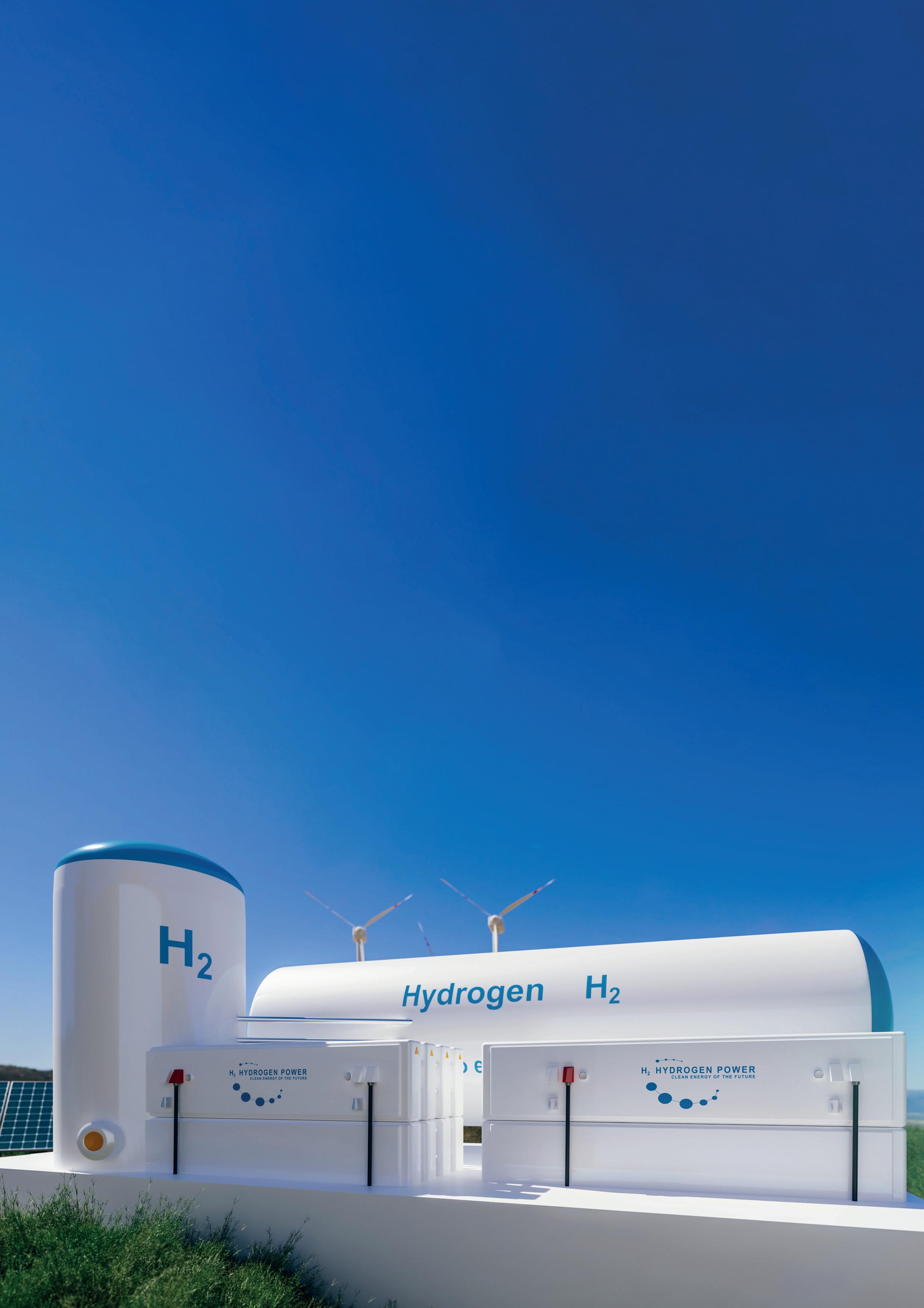
HYDROGEN FOR HOME HEATING
When it comes to heating homes, hydrogen is not the most costeffective solution. Due to its lower energy density, a significant amount of hydrogen would be needed to generate the same heat as natural gas. This makes it an expensive option for home heating.
HYDROGEN FOR CARS
Similarly, using hydrogen to power cars also presents challenges. Hydrogen fuel cell vehicles are expensive to manufacture, and the infrastructure for hydrogen refuelling is still limited. Moreover, electric vehicles, which are becoming increasingly efficient and affordable, offer a more viable alternative.
ALTERNATIVES TO HYDROGEN
So, if not hydrogen, then what? For home heating, heat pumps and biomass boilers are proven, efficient alternatives. For vehicles, electric cars powered by renewable energy are the most promising solution.
That being said, hydrogen does have a role to play in the green economy. It can be effectively used in sectors where electrification is challenging, such as shipping and heavy industry.
As we move towards a more sustainable future, it’s crucial to make smart, responsible business decisions. While hydrogen has its place in the green economy, it is not the silver bullet solution for all our energy needs.
45 HYDROGEN
LEEDS’ TRAILBLAZING WITH UK s FIRST SOLAR-POWERED
PARK AND RIDE
The park and ride service in Stourton marks Leeds’ third project of this kind. However, the uniqueness of this service lies in its power source – solar modules and a sophisticated battery storage system. This eco-conscious effort is anticipated to reduce nearly 471,000 KGCO2e of carbon emissions in 2022, embodying the council’s commitment towards a greener future.
The project utilises a 1.2MWp SolarEdge solar system, a smart EV charging infrastructure, and a 950kWh battery storage system. This allows the park and ride site to function beyond daylight hours, powered by the energy stored in the battery. The system is projected to generate approximately 852,000 kWh of electricity annually.
The solar installer Evo Energy selected the SolarEdge DC-optimised system to maximise efficiency. This system helps overcome energy loss due to module-level mismatch, which could have posed a significant challenge had string inverters been used. SolarEdge’s Power Optimisers enable each solar module to operate at peak efficiency, thus mitigating the effects of shading, uneven panel degradation, or extensive soiling. This ensures higher energy generation, even as the solar modules age at different rates, thereby minimising the string effect.
EvoEnergy’s Principal Renewable Energy Consultant, Jonathan Roper, praised the project, stating, “This site highlights how a project can positively impact a community, the local economy, and businesses throughout the city by enabling renewable energy powered transportation and enhancing the volume of transport links.”
A KEY ROLE IN LEEDS’ CARBON ZERO STRATEGY
This pioneering endeavour forms a crucial component of Leeds City Council’s strategy to reach carbon neutrality by 2030. It aims to alleviate congestion and pollution within the city centre and is partially funded by the Department for Transport and a grant from the European Regional Development Fund. With the battery storage in place, approximately 12% of the energy produced will be exported to the grid. The remaining energy will be stored and used to power the facility when sunlight is unavailable. This proactive approach to load shifting could see the site’s grid importation reach virtually zero for most of the time.

A BOON TO LOCAL ECONOMY AND INFRASTRUCTURE
The Stourton park and ride site, bolstered by its solar power and battery storage system, supports 26 electric vehicle charging points, ensuring

SUSTAINABLE TRANSPORT 46
47 SUSTAINABLE TRANSPORT RIDE
a sustainable commute for the city’s residents. The site also provides secure cycle storage and parking space for approximately 1,200 vehicles. This £38.5 million public transport project is served by zero-emission electric buses that transport commuters to Leeds city centre every ten minutes via dedicated bus lanes. Tracy Brabin, Mayor of West Yorkshire, heralded the project, stating, “Being able to launch the UK’s first solar-powered park and ride is a massive achievement for Leeds and a major boost to both the local environment, economy, and the city’s public transport infrastructure.”
SETTING A PRECEDENT FOR OTHER CITIES
The success of the Leeds project has prompted other cities to explore the potential of solar power and storage in their park and ride sites. Cambridgeshire County Council has received planning permission for a 948kW system at the St Ives’ Park & Ride, further progressing in July 2021 with a £2 million grant towards its construction. The council has also announced plans for a 2.5MW solar carport with battery storage at the Babraham Park and Ride in Great Shelford Parish.
Carports, with their dual functionality of providing shelter to parked cars while housing solar panels, are gaining popularity among councils.
The City of York Council is constructing a 400kW solar carport, while Oxford City Council and Northumberland County Council are also installing similar systems.
AN ECO-FRIENDLY CONSTRUCTION
The Stourton park and ride centre, while a marvel of sustainable technology, also pays homage to the natural environment. The centre is surrounded by a multitude of trees, compensating for the greenery lost during construction at a ratio of 54:1. The internal landscaping comprises trees in the central area, planters, and hedges which break up sections of the car park. The building incorporates a green roof and a green wall, further accentuating the site’s “green” credentials.
The facility also boasts solar panels, LED lighting, electric vehicle charge points, and electric buses serving the Park & Ride site, ensuring a low carbon footprint, both currently and in the future.


TRAILBLAZING SOLAR-POWERED
The city of Leeds has made a groundbreaking stride in the journey towards sustainability by launching the first solarpowered park and ride system in the UK. This revolutionary scheme, located in the suburb of Stourton, not only offers an eco-friendly commute but also aids in reducing traffic congestion and carbon emissions in Leeds’ city centre.
Green energy groups step up training
Companies and educational groups across the UK and Europe are ramping up training programmes to close the burgeoning green skills gap, as demand surges for workers that can install and maintain renewable energy sources.
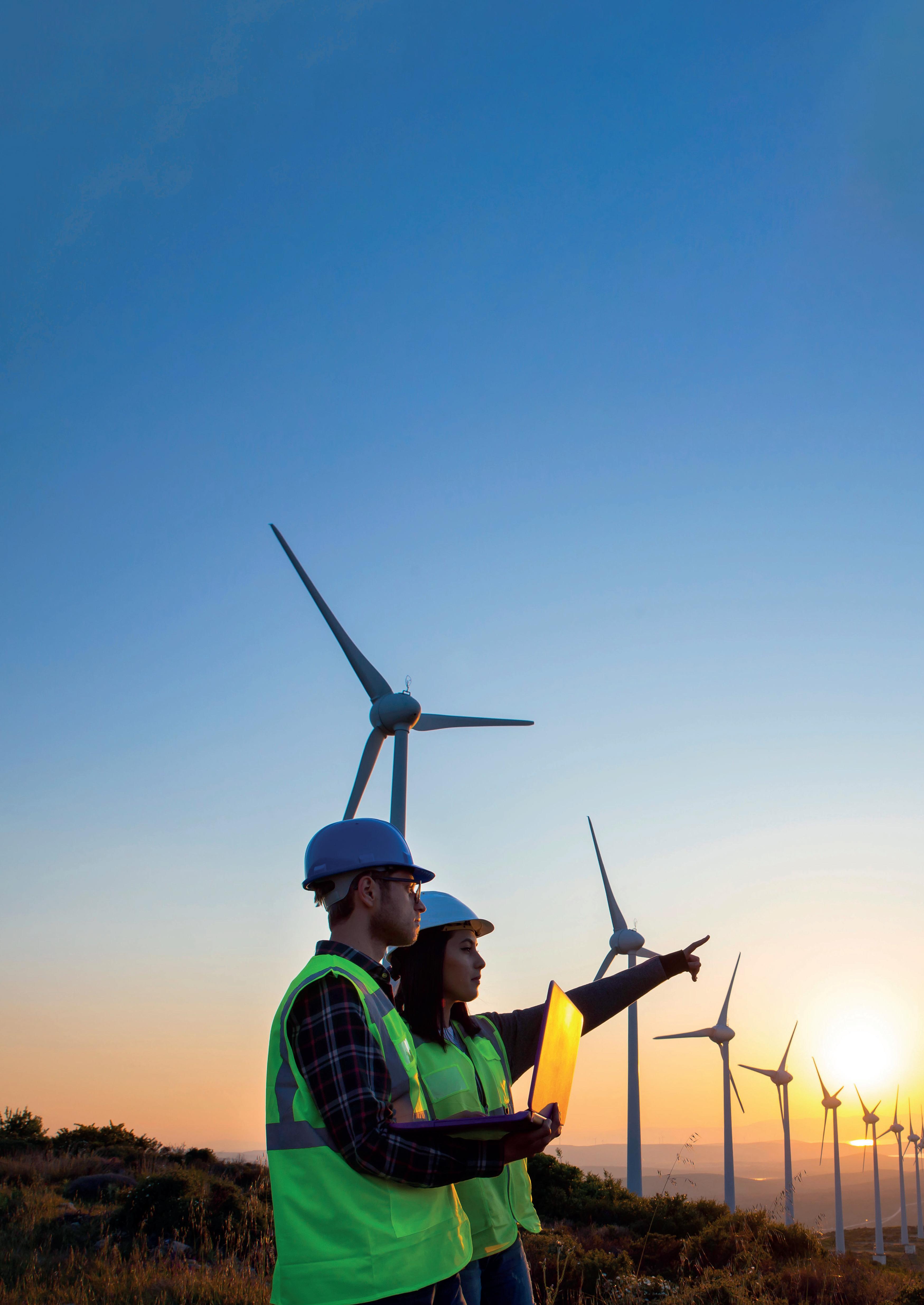
The training targets the areas of greatest immediate shortage, including heat pump and solar panel installation, residential and commercial building upgrades and electric vehicle charging installation.
The training targets the areas of greatest immediate shortage, including heat pump and solar panel installation, residential and commercial building upgrades and electric vehicle charging installation.

Across Europe, more than 1mn solar workers will be needed in the next seven years to meet 2030 renewable energy targets, the SolarPower Europe industry body estimates.
In the UK alone, PwC forecasts that up to 66,000 new heating engineers, insulation specialists and glaziers will need to be added to the workforce each year in the medium term.
Many skills in demand, however, require a high level of professional and scientific expertise that involves years of training, rather than weeks or months. Roles in nuclear power, and safety and engineering made up more
GREEN ENERGY 48
to close skills gap
than half of the job advertisements surveyed by labour market analytics company Lightcast. Mechanical and electrical engineer positions accounted for another 20 per cent of “green” vacancies, it found. But for roles that do not require several years of education, corporate inhouse training and technical academy programmes are attempting to fill the gap.
The British renewable energy group Octopus runs a training centre in the industrial area of Slough, where it says it can provide fully funded training for up to 1,000 staff a year in installing renewable energy systems.
“Most of [those] who we employ right now are people who have some experience in gas or heating and are thinking about whether there will be a career installing gas boilers in five or 10 years from now,” says Octopus energy services chief executive John Szymik.
Training is carried out in two full-sized houses where staff can practice removing gas boilers and installing heat pumps, as well as how to interact with customers and explain the new technology to them. Szymik says it usually takes three to four weeks to retrain new staff.
Munich-based renewable energy company BayWa r.e. started an internal “engineering academy” this year, running courses attended by around 40 staff a month, mostly by would-be solar engineers.
Statkraft, another renewables provider headquartered in Oslo, is offering stints in design and procurement across different types of renewable energy projects.

Recruitment companies are also taking advantage of government-funded schemes aimed at training the workforce of the future.
The UK’s new £5mn heat training grant offers £500 towards learning how to install heat pumps at 60 approved training centres. The government has
also pledged £8.9mn to train retrofitters, and promised a heating technician apprenticeship scheme later this year. Another £63mn is earmarked for “returnerships”, which would include green reskilling, designed to attract those aged 50 and above who are looking to re-enter the workforce.
The UK-based employment group Reed last month launched a green jobs arm aimed at recruiting 1,000 each year, in partnership with the Oxford Energy Academy, a heating and plumbing training and assessment centre. The training will involve building insulation, double-glazing, improved ventilation design and installation of more efficient heating systems.
Reed Environment said it would target those registered as unemployed, as well as local businesses and authorities, with the training supported by the fees paid by the participants and the government grants.
The Oxford Energy Academy also offers training in EV charger and solar panel installations, paid for by self-employed individuals and companies. Most of those it trains are already established as plumbers, electricians and engineers, it says.
“We get a mixed bag in each classroom, some people sail through the course in three days, other take five. It depends on their level of knowledge and plumbing skills going in,” said OEA director David Bendell.
Reed Environment director Tom Hoines says that retrofitting also offers an opportunity for new starters, such as school leavers, as well as those changing jobs. “You don’t need years of experience or an existing qualification,” he notes.
London-based education provider City and Guilds has also launched courses in EV charger installation and retrofitting, which can be funded by the government depending on age and income, and has awarded bursaries to disadvantaged individuals to train in EV charger installation.

But industry associations note there remain large hurdles to developing at scale and speed the skill base needed for the green energy shift among existing small business owners.

Many tradespeople are self-employed, so taking time out to reskill carries a risk of lost income.
“I think we’ve got to be mindful that the £500 might cover the cost of the course, but it won’t cover the amount of money they would have made in the five days they haven’t worked,” says Charlotte Lee, chief executive of the Heat Pump Association in the UK, estimating that about 40,000 people from its membership base could be trained to install heat pumps each year.
Tradespeople nearing the end of their working lives also may not see an incentive in preparing for new technologies.
“The question for some of them is ‘can I just keep doing what I’m doing for a few more years until retirement?’” says Carl Sizer, PwC UK’s head of regions.
49 GREEN ENERGY training
Many tradespeople are self-employed, so taking time out to reskill carries a risk of lost income.
HOW CAN BUSINESS SAVE ENERGY TO REDUCE AND WORK TO SAVE THE ENVIRONMENT

Becoming more energy efficient not only saves benefit your business’ working environment and
According to research by the Carbon Trust, for many businesses, a 20% cut in energy costs represents the same bottom-line benefit as a five percent increase in sales. To cut these costs, business owners should be taking action in three areas:
• Energy efficient practices
• Renewable technology
• Their workforce
Businesses implementing energy-saving practices across these areas may find that they see a number of benefits such as:
• Increased productivity
• Reduced energy bills
• Improved business green credentials

• Enhanced reputation
• Reduced exposure to future energy rises
• Wider benefits to society, such as reduced carbon emissions and improvements in air quality
So, what measures should businesses be implementing?
Energy Efficiency Practices
Saving energy starts at the source. Businesses must consider how they use energy in their workplaces plus areas of waste and how to minimise this. To begin this process, it is a good idea to consider where your energy is going; conduct a business energy audit to identify where energy is being wasted and prioritise areas that need change most urgently and install a smart meter to see how much energy you’re using. Smart meters can also identify areas of waste and help improve energy efficiency.
prepare
Key areas for business energy waste include:
• Lighting: according to the Energy Saving Trust lighting makes up 11% of the average UK household electricity consumption. To save energy, businesses should encourage their employees to turn lights off when they aren’t being used, consider using automatic lighting to prevent lights from being left on accidentally and/or switch to LED lighting – LED bulbs use less energy and cost less in the long run.
• Heating: controlling the heating in your workplace to maintain a good working temperature can help to minimise wastage. You can use a regular thermostat to regulate this or consider a smart thermostat to turn the heating on and off and intervals to maintain the perfect temperature.
• Equipment: managing office equipment can reduce the amount of energy it consumes by up to 70%. Encourage employees to ensure equipment is off when not in use and is never left on after working hours. For the longer term, invest in energy-efficient equipment for a less wasteful office set-up.
A SUSTAINABLE FUTURE 50
OWNERS REDUCE COSTS ENVIRONMENT saves you money, it can also prepare you for the future.

Invest in renewable technology
McKinsey estimates that by 2035 renewables will generate 60% of the world’s electricity. For business owners, it is important to begin considering the role that renewable technology will play in the workplace. Examples of renewable technologies include:
• Solar panels: investing in solar panels can reduce your power consumption as your business will be generating electricity instead of relying on the grid.
• Voltage optimisation: voltage optimisers reduce the amount of electricity powering your equipment to the optimal voltage needed and reduces the amount of electricity wasted.

• Heat pumps: these electricity to generate heat instead of relying on a gas boiler and so they reduce gas consumption.
Include your employees
Including your employees in your energy efficiency plans will help build a company-wide commitment to energy saving. If employees are unaware of the benefits of energy-saving programmes, they are not going to have the motivation or drive to help the business implement them.
• Educate your employees: train them on environmental issues and energy management.
• Place posters and stickers around the workplace: improve their awareness of energy efficiency – the more awareness they have, the more they will feel a part of the bigger picture.
• Set clear efficiency goals: incentivise and reward employees for their positive behaviour as this will help to build an internal company culture of energy saving.
The energy crisis is still throwing up challenges for businesses across the industry. Whilst the government is currently offering support through the energy bills discount scheme, it is important that businesses implement their own energy-saving measures to stay protected from further disruption.
51 A SUSTAINABLE FUTURE BUSINESS




COMING SOON & Powered by





















































































































































